1 BJT Bipolar Junction Transistor

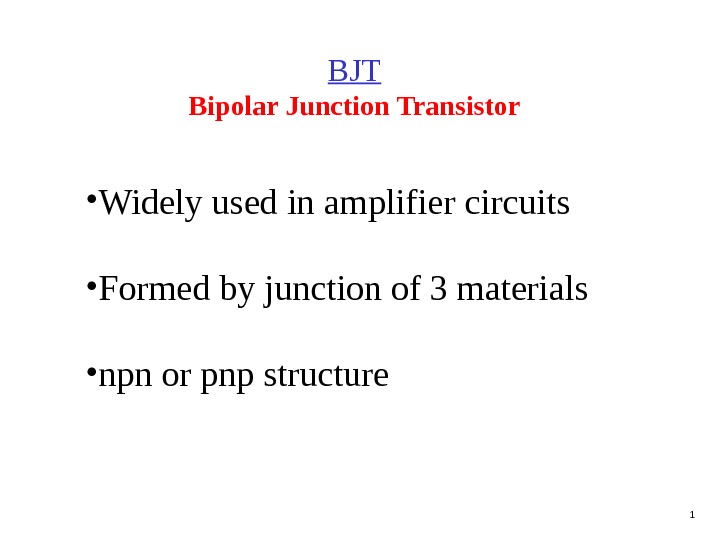
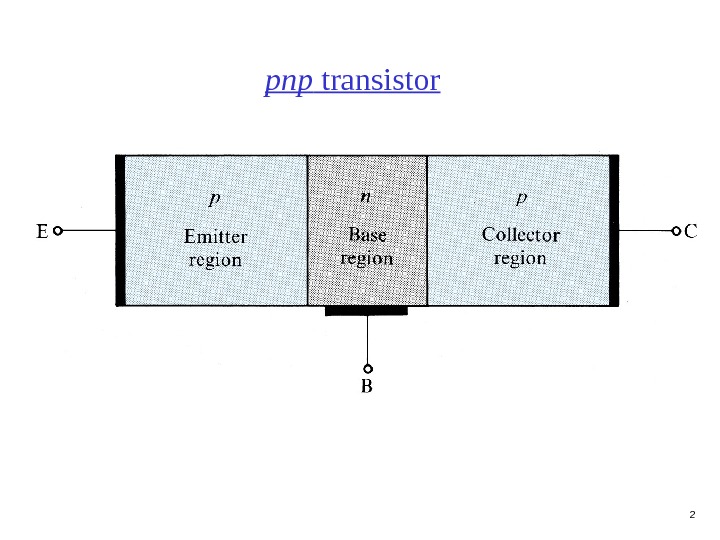
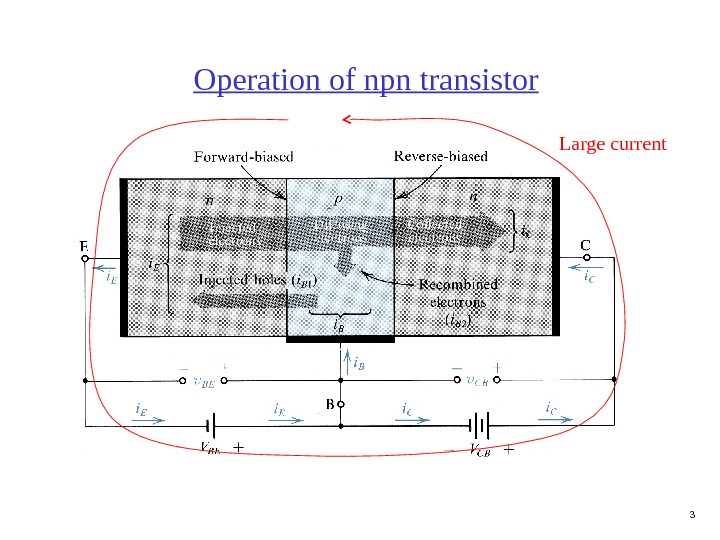
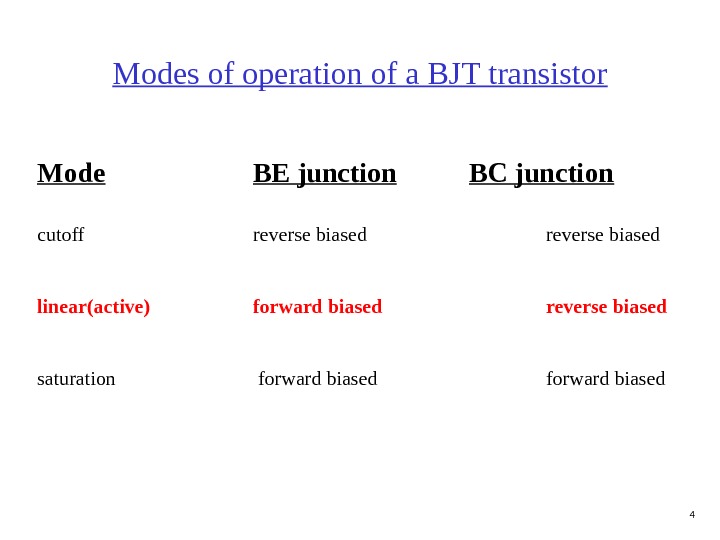
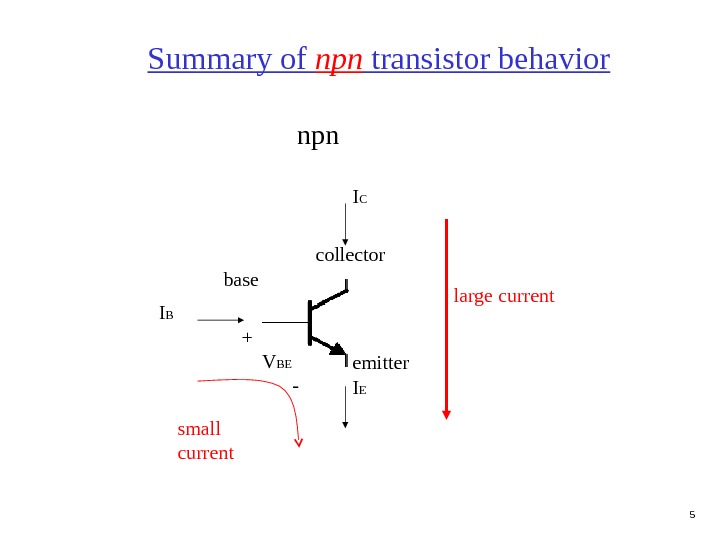
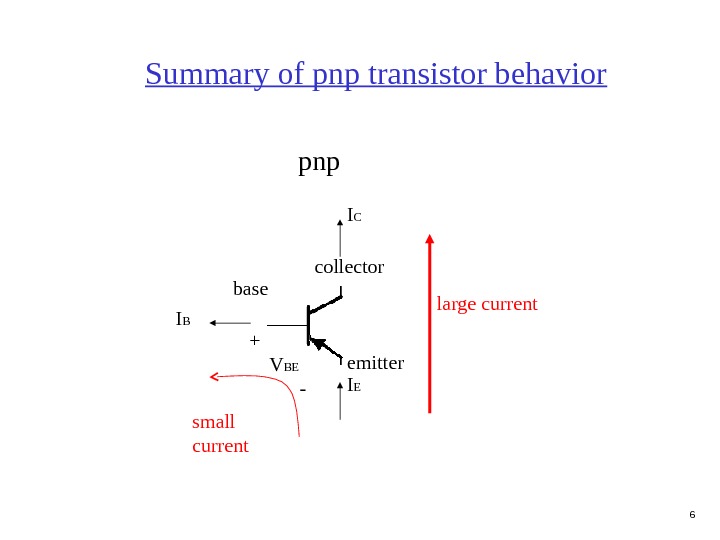
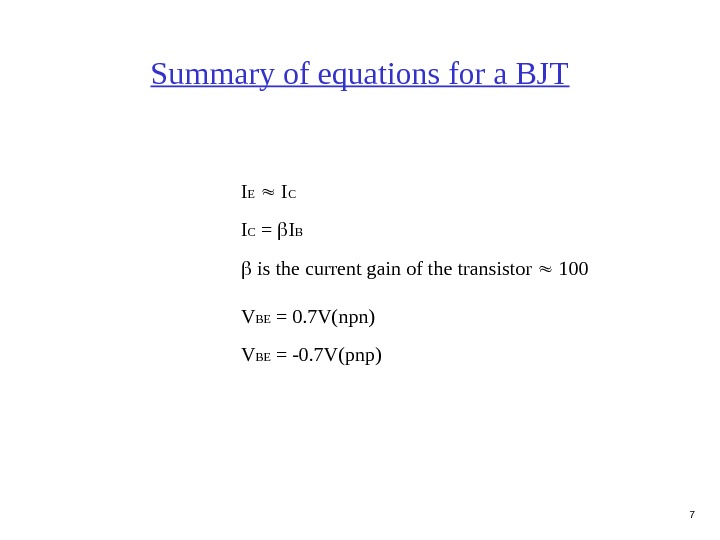
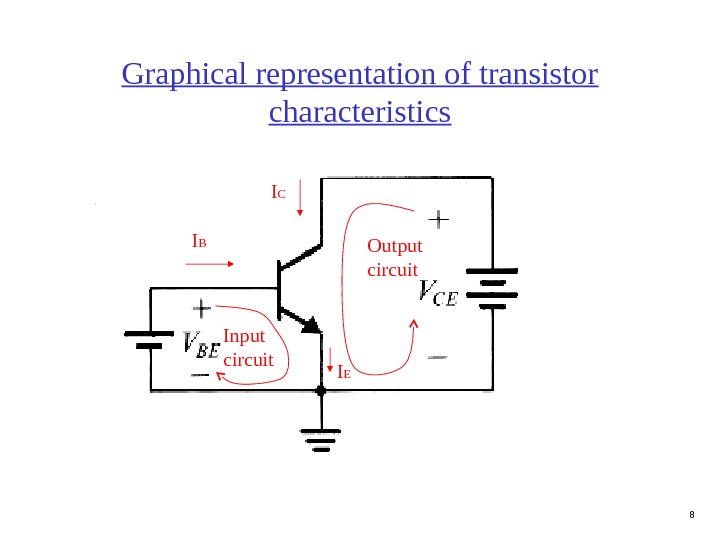
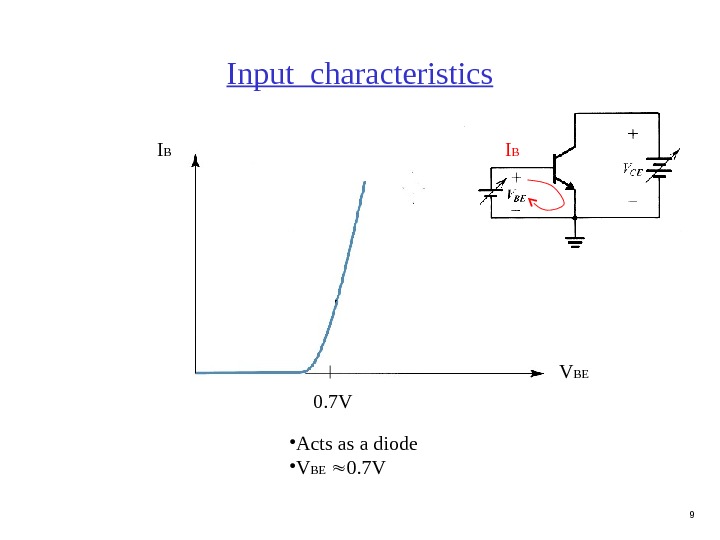
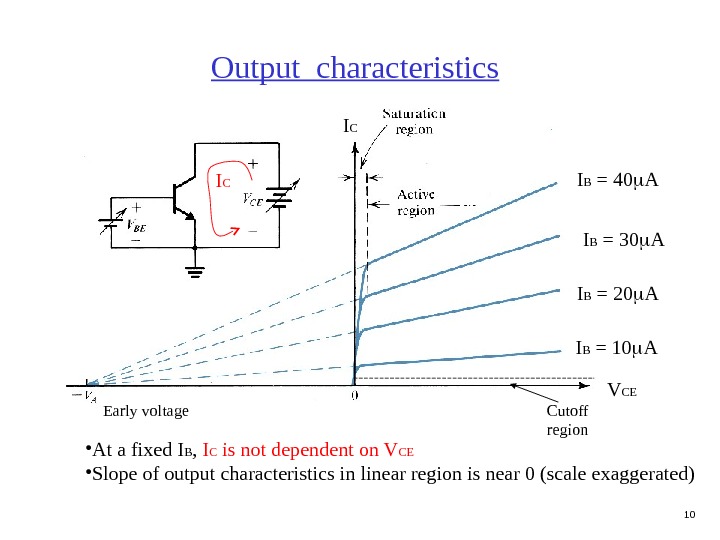
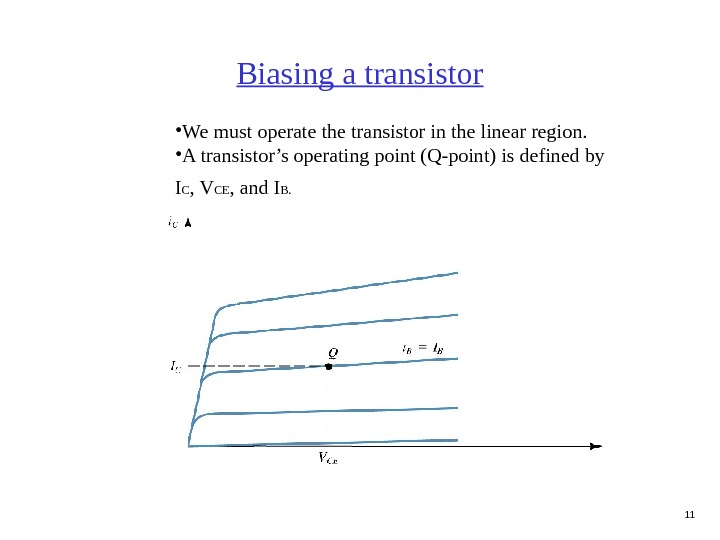
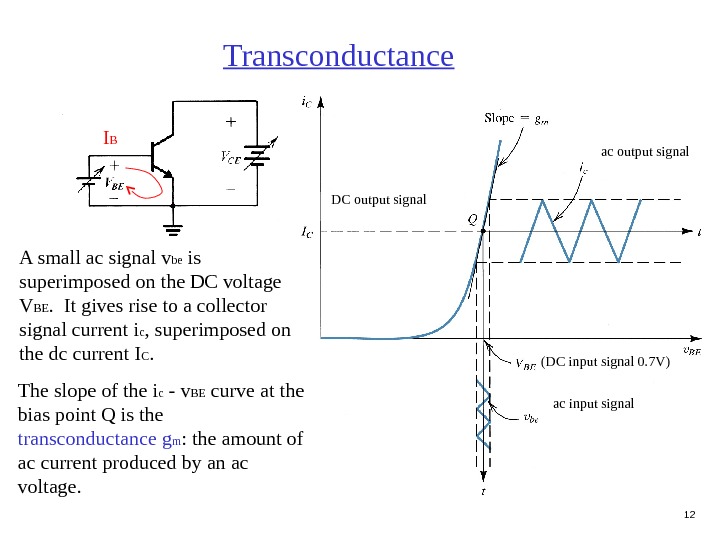

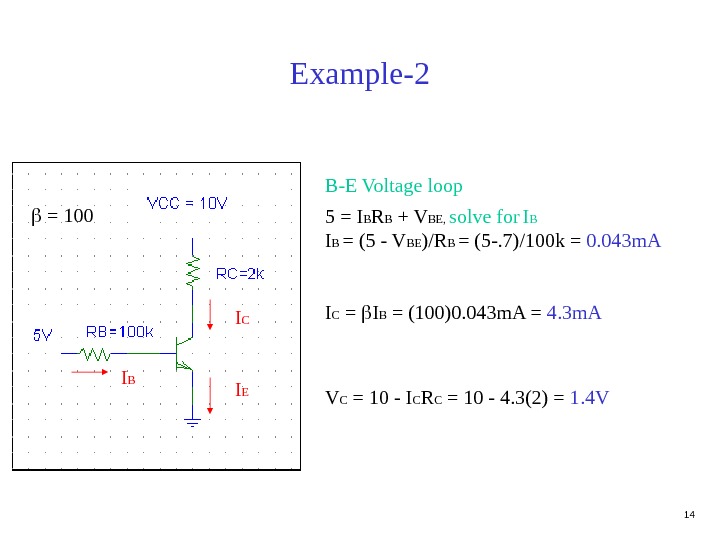
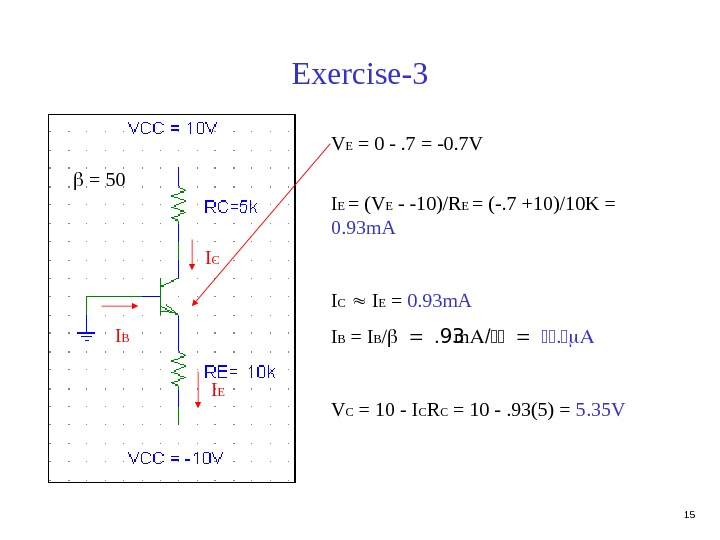

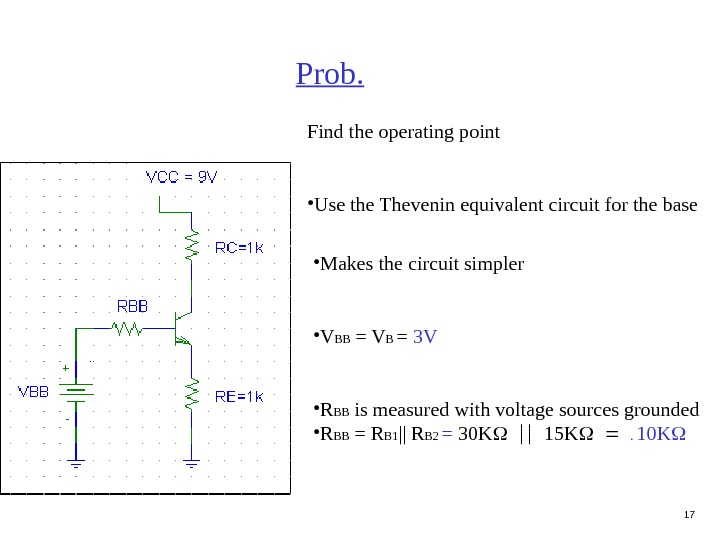
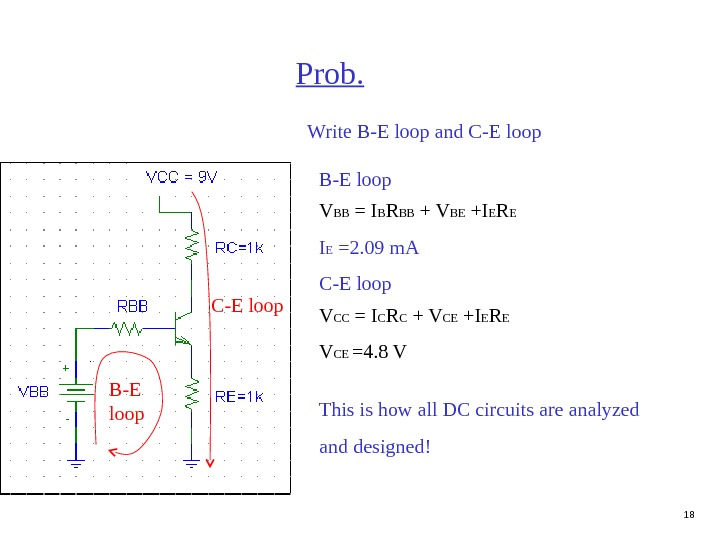
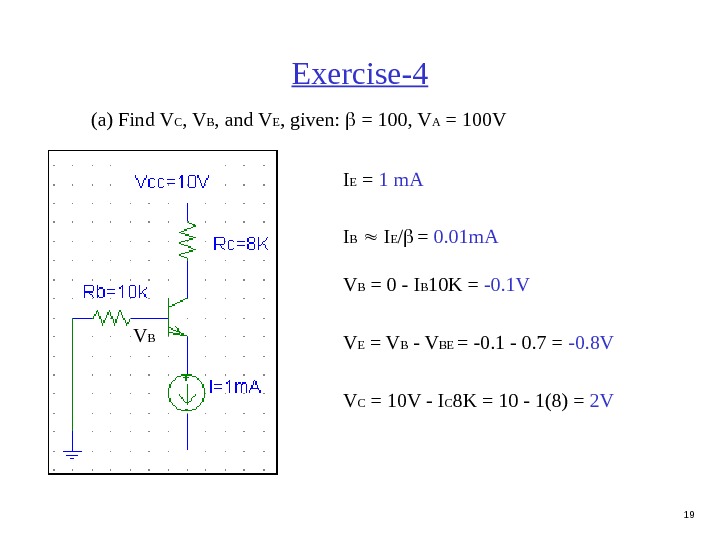
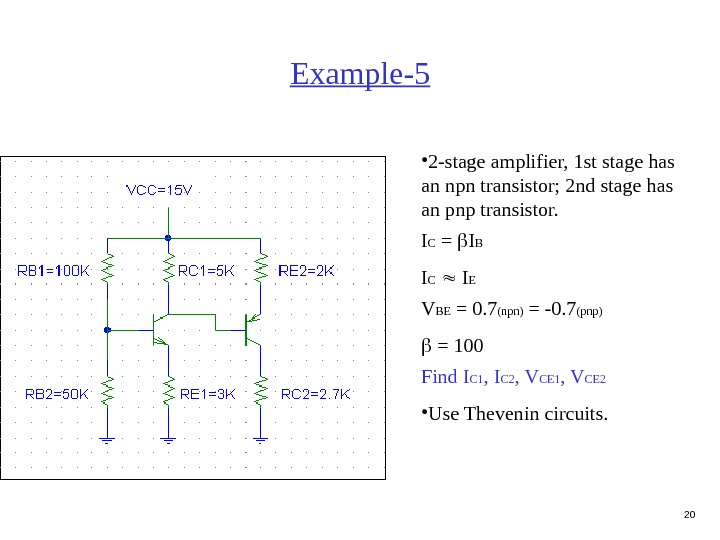
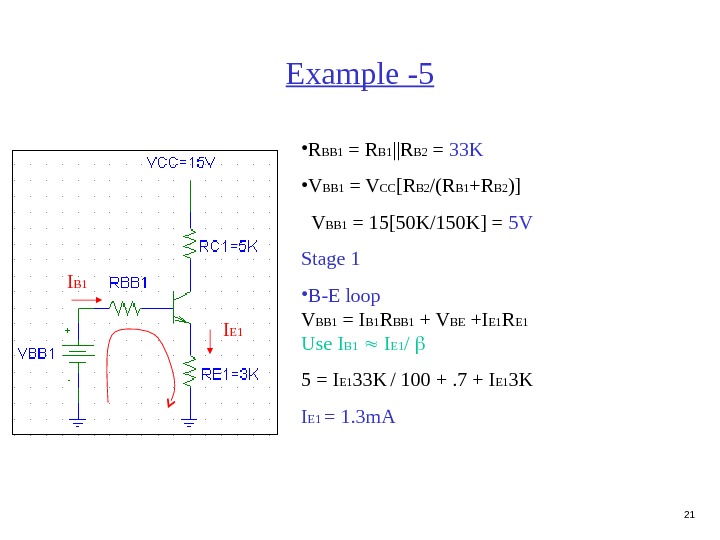
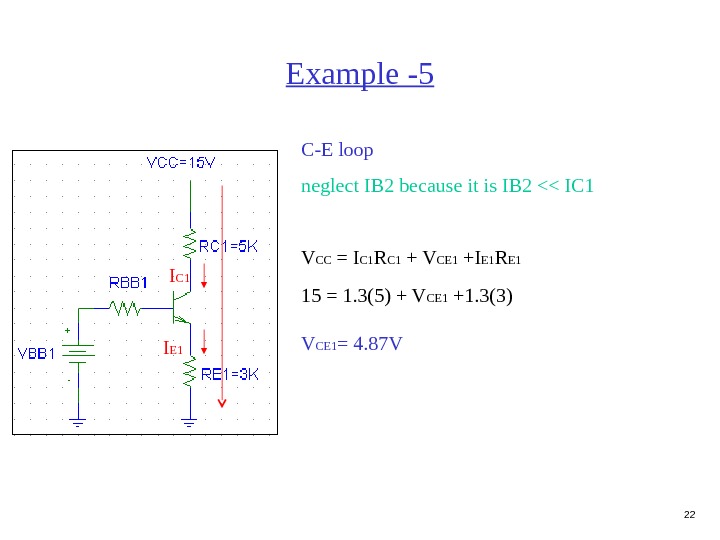
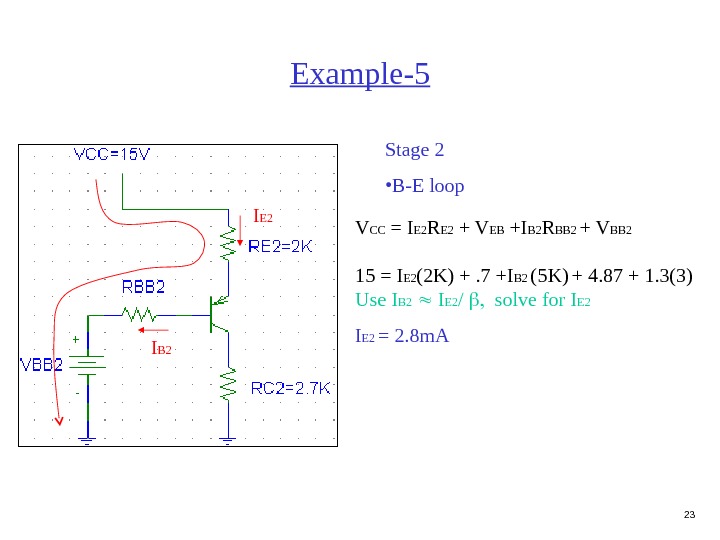
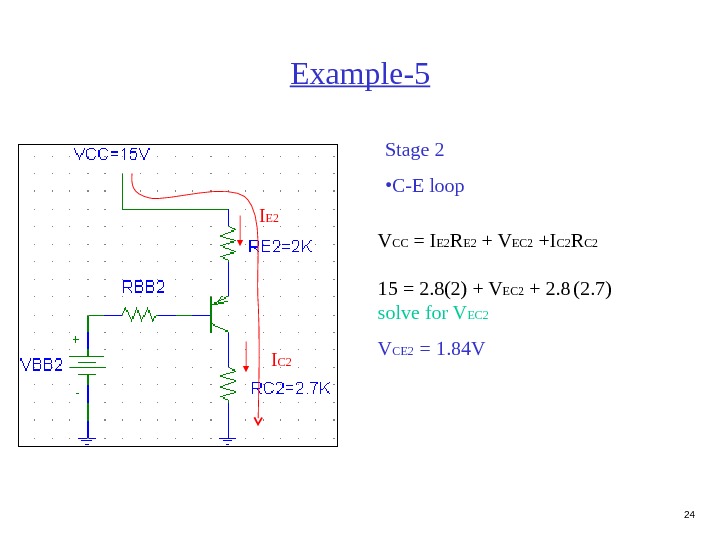
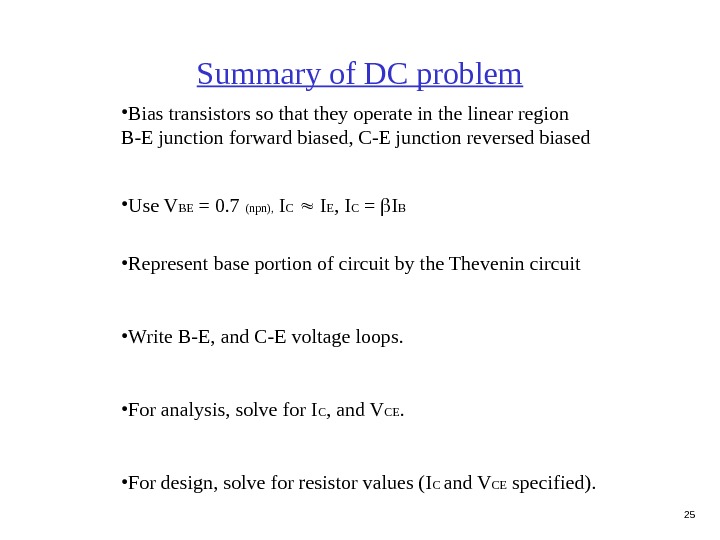
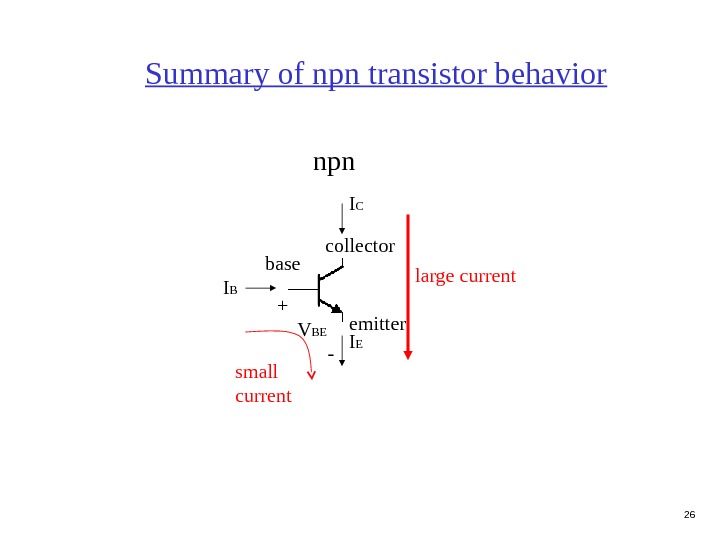
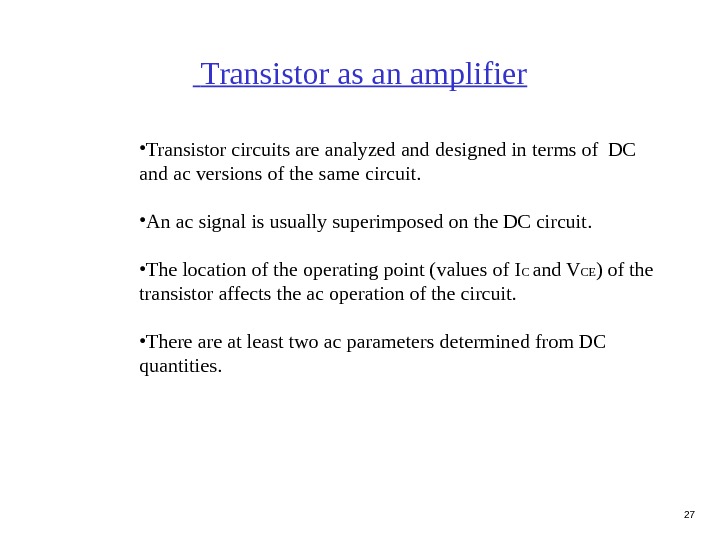
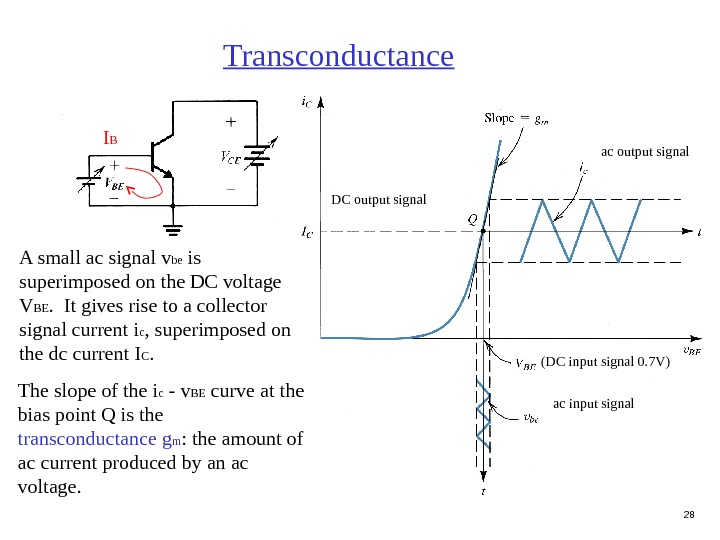
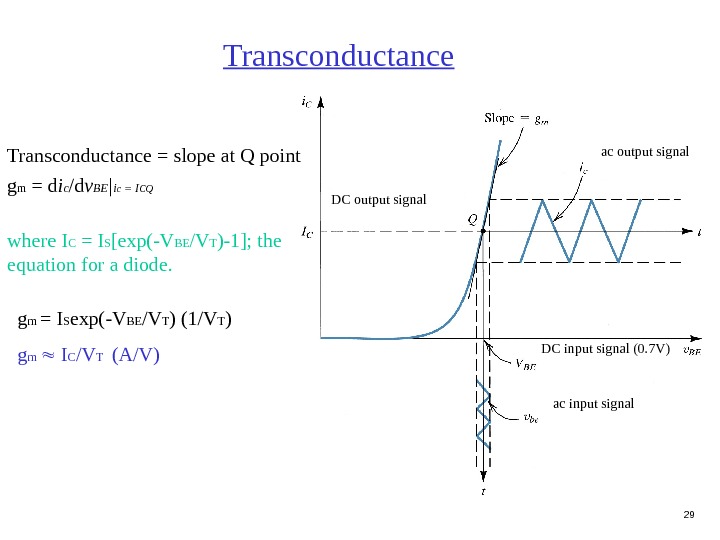
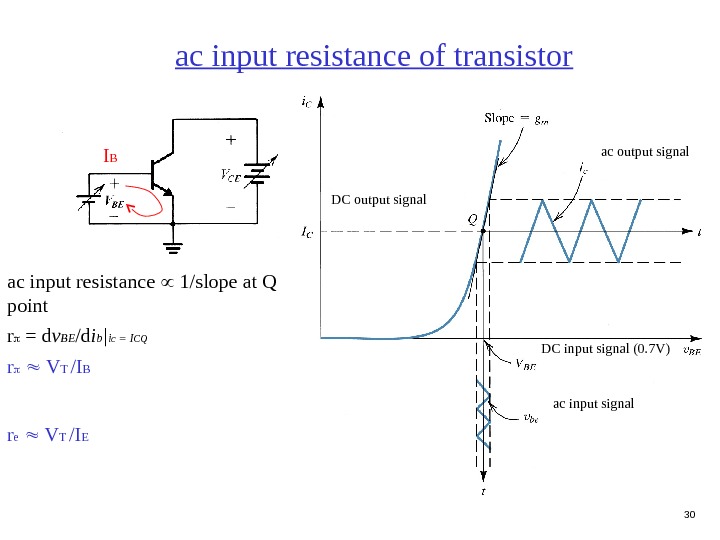
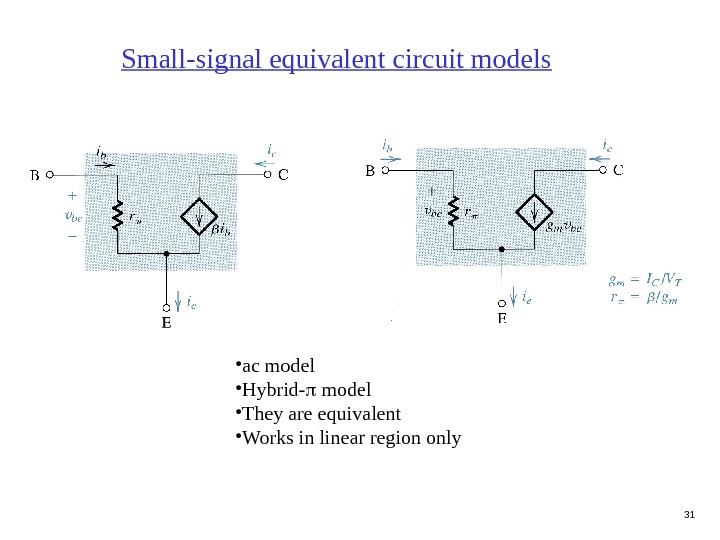
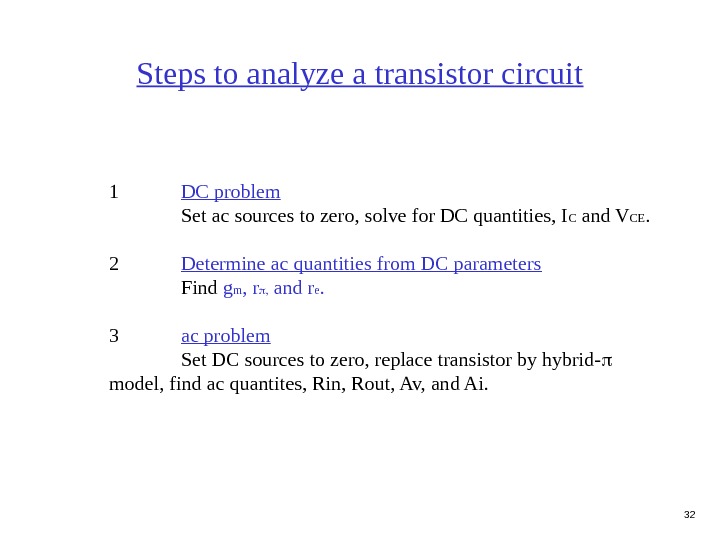
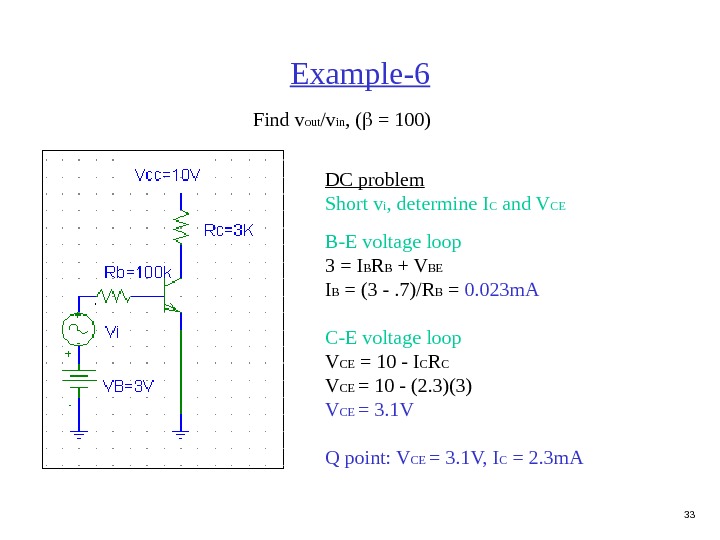
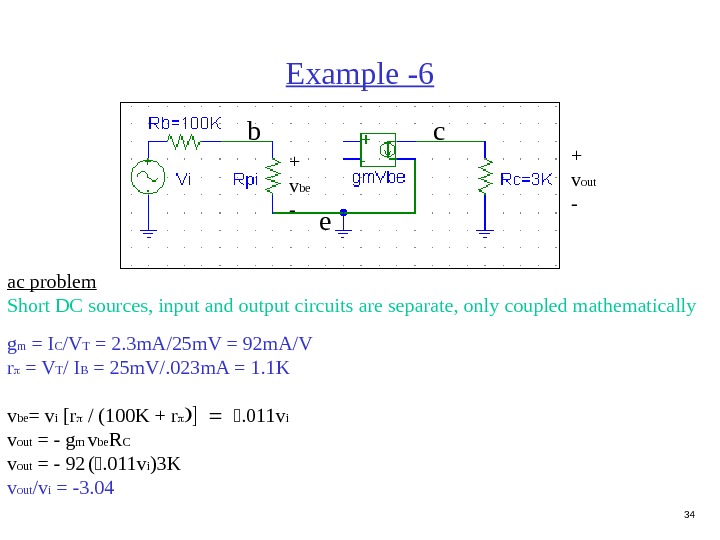
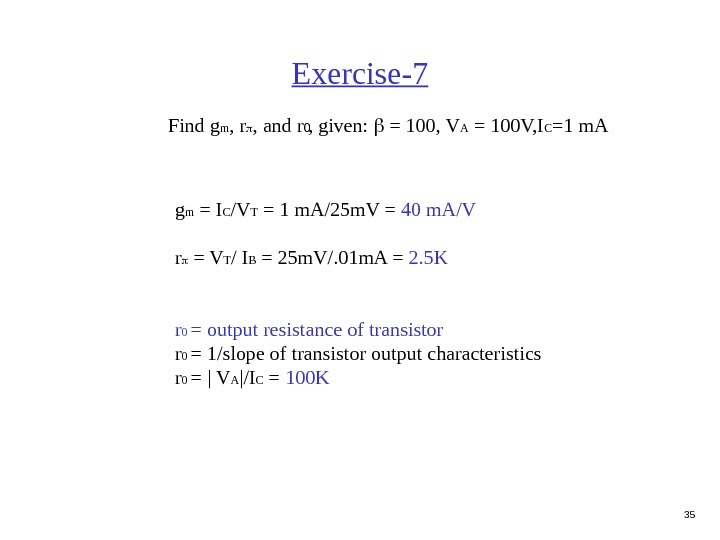

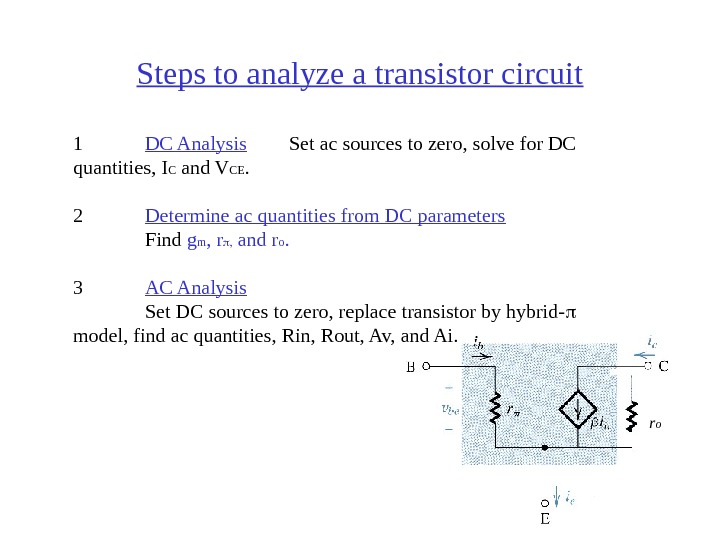
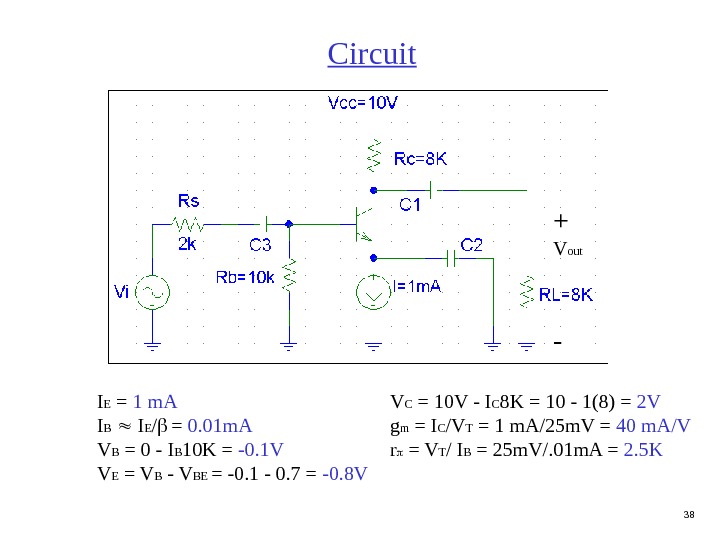
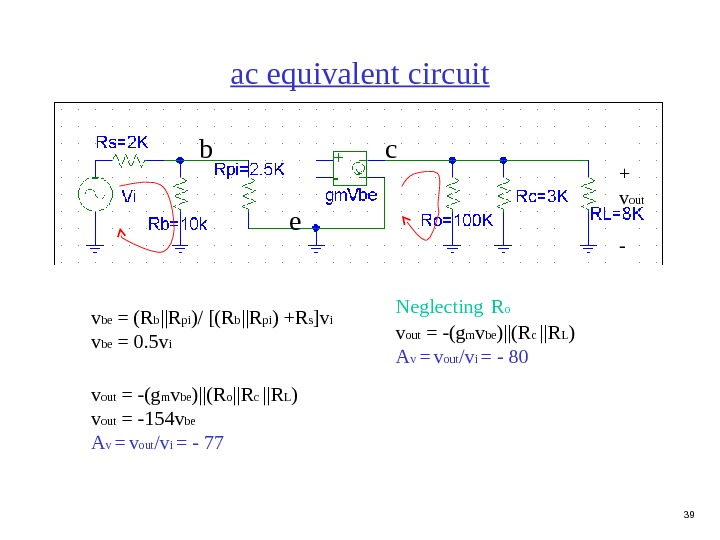
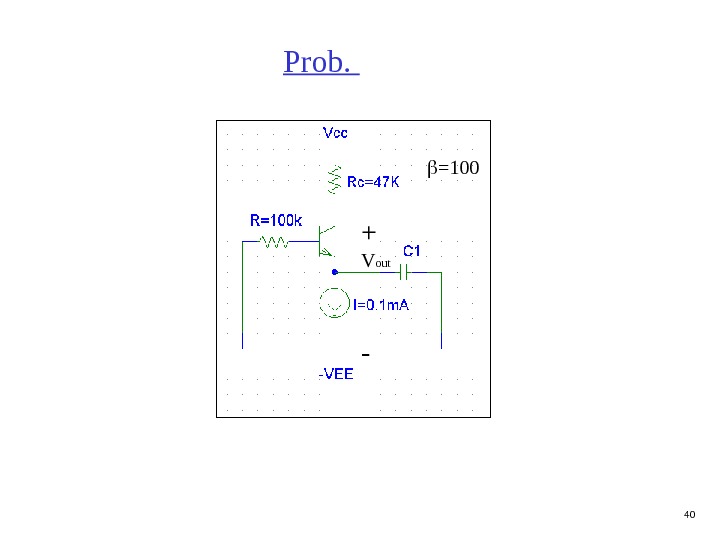
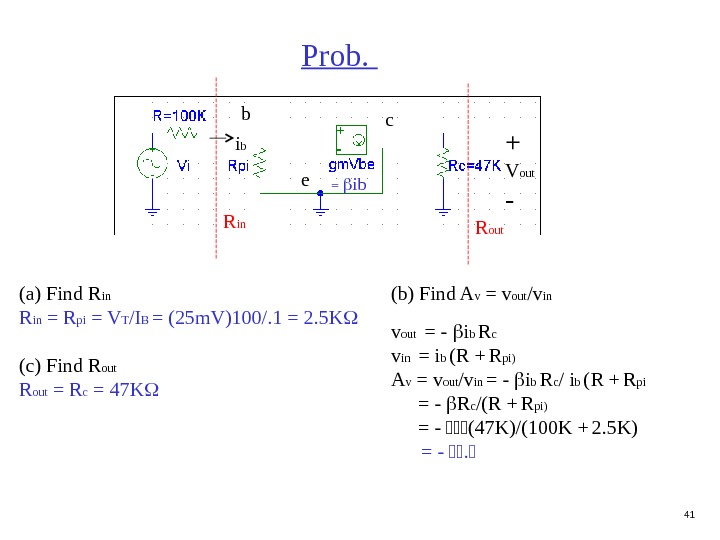
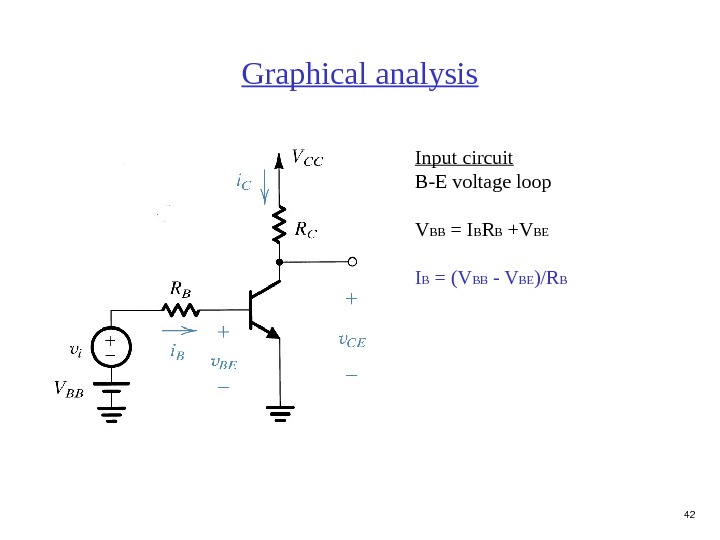

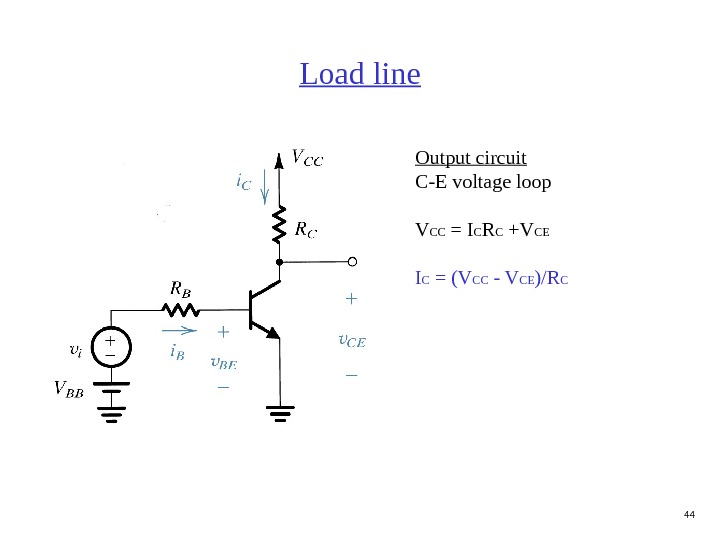
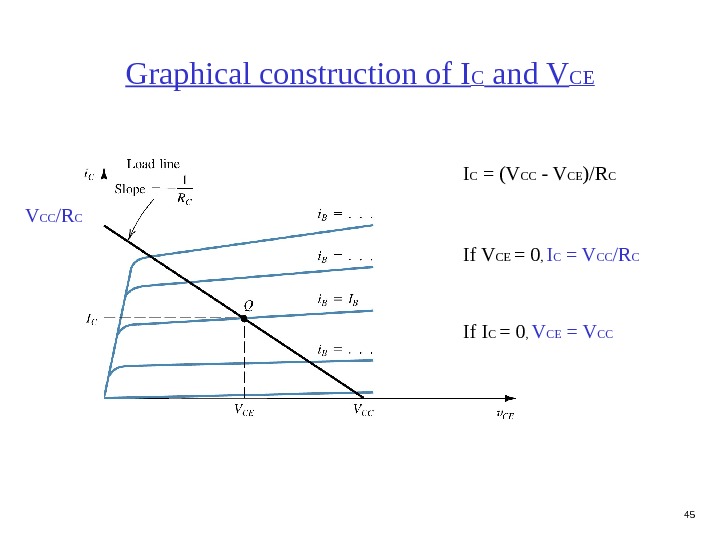
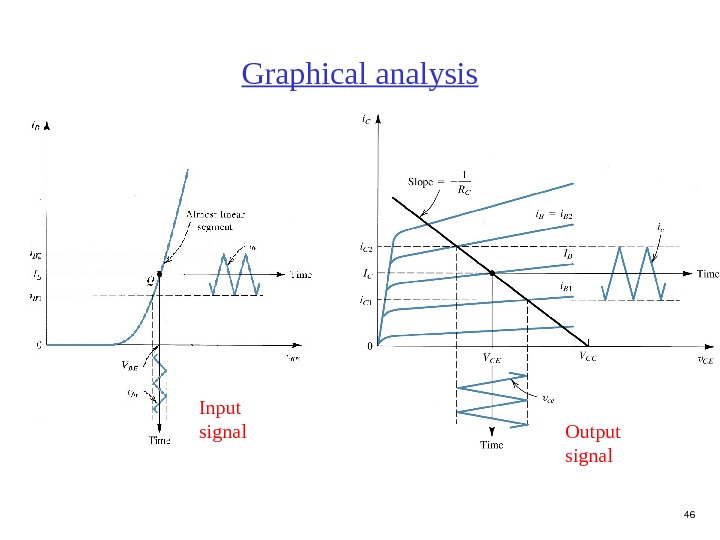
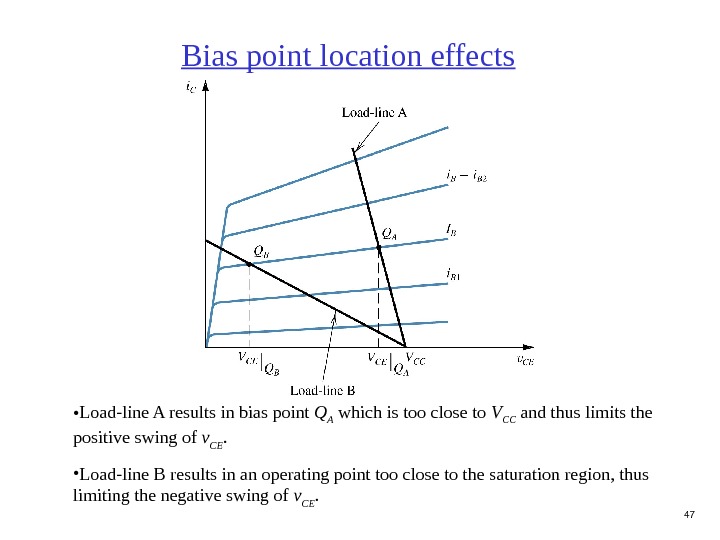
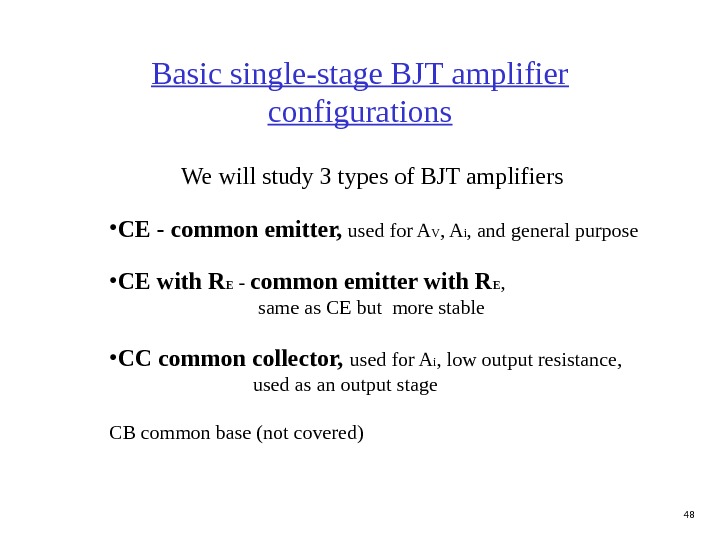
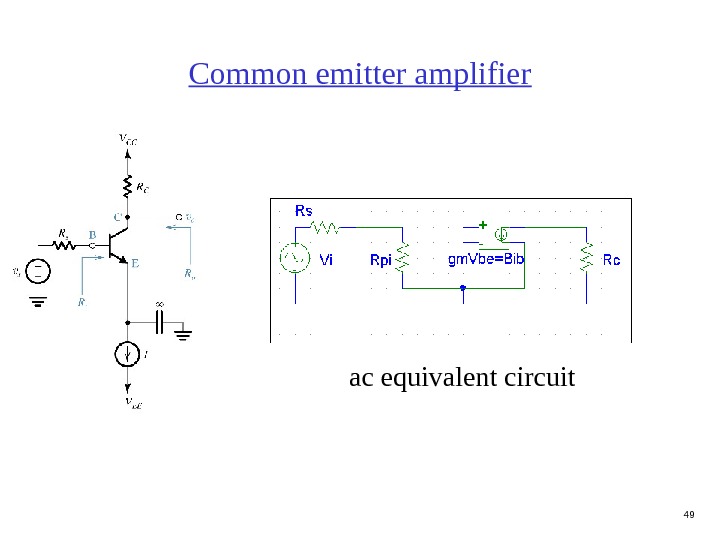
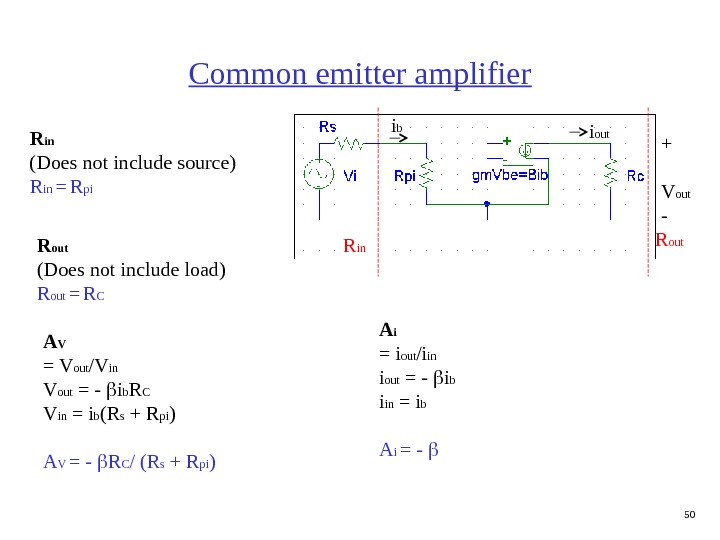
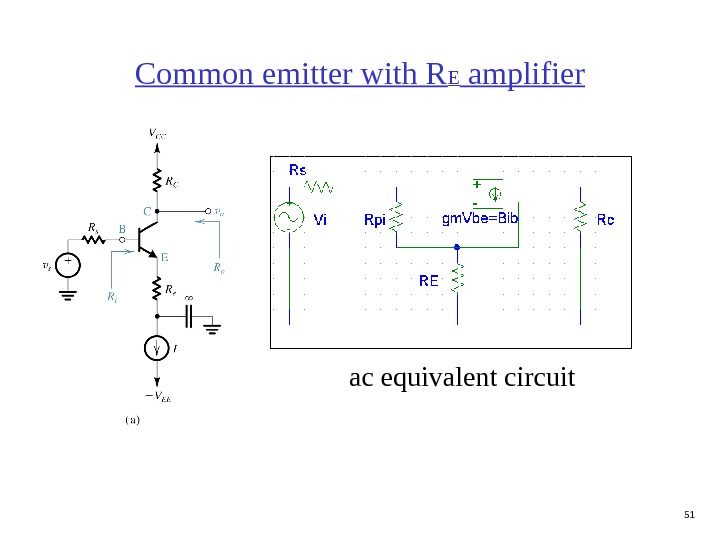

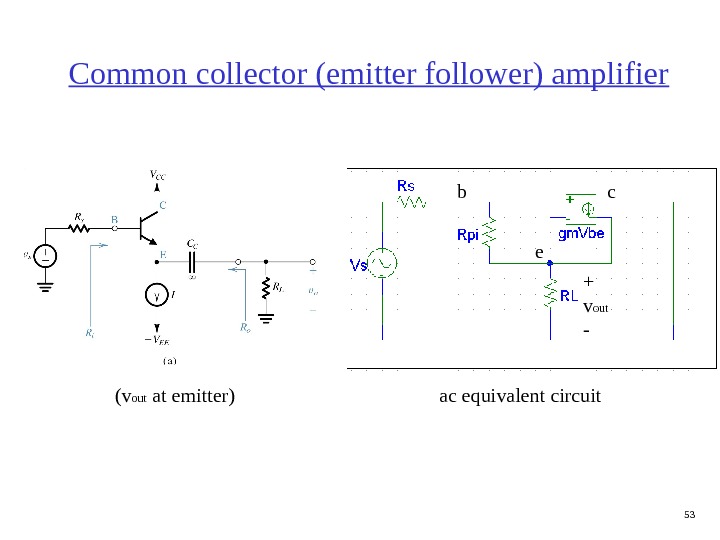
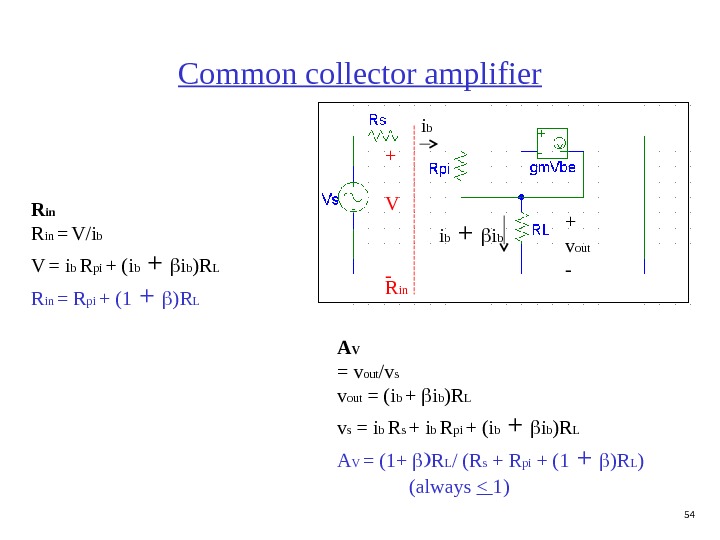
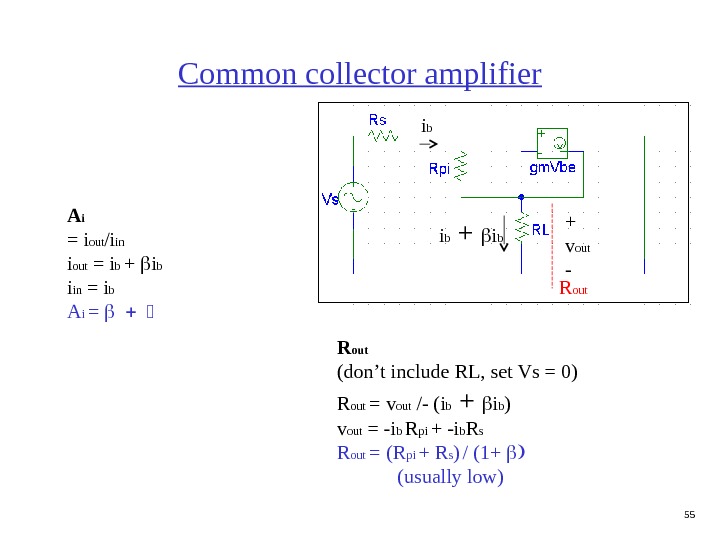
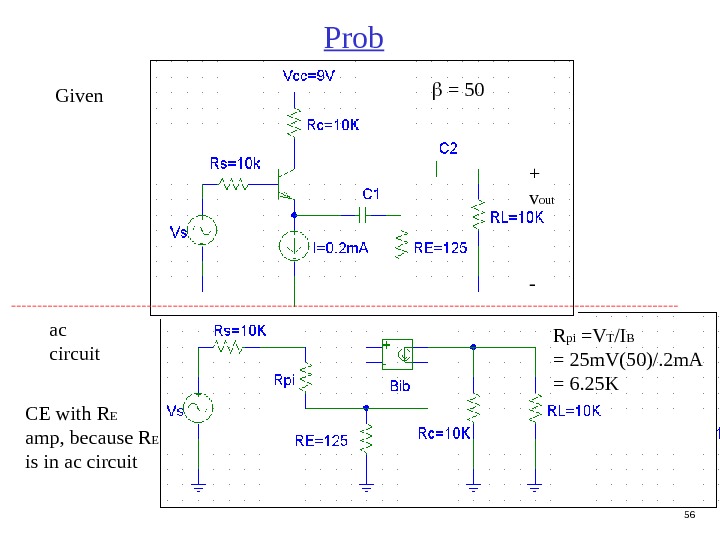
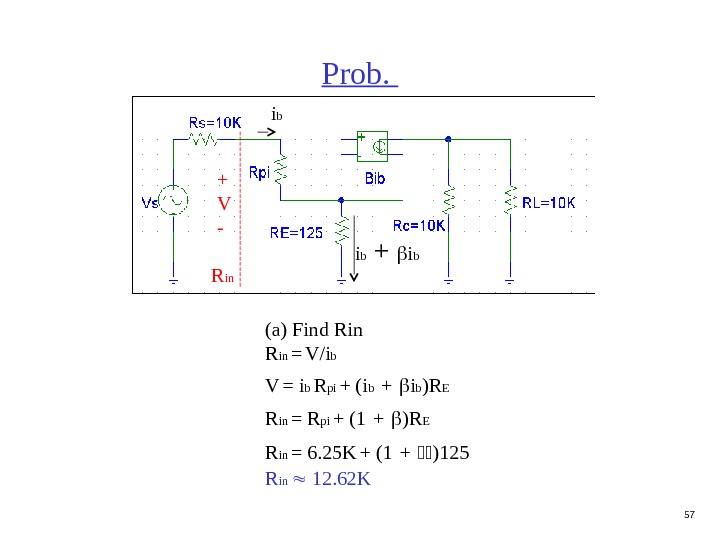
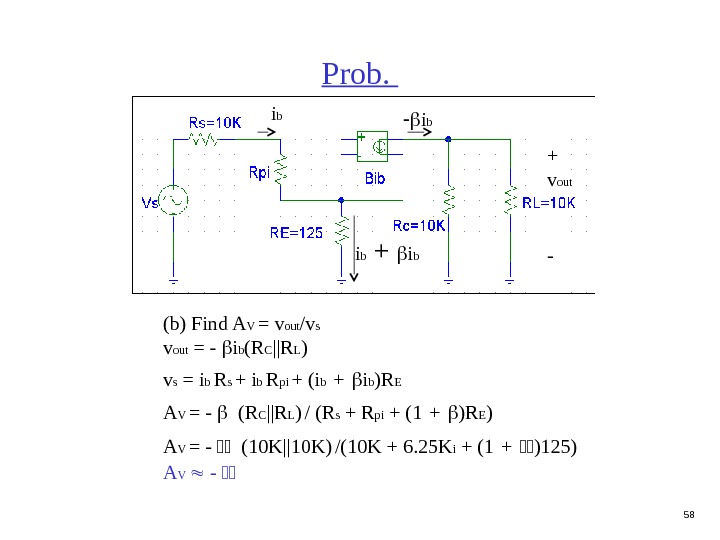
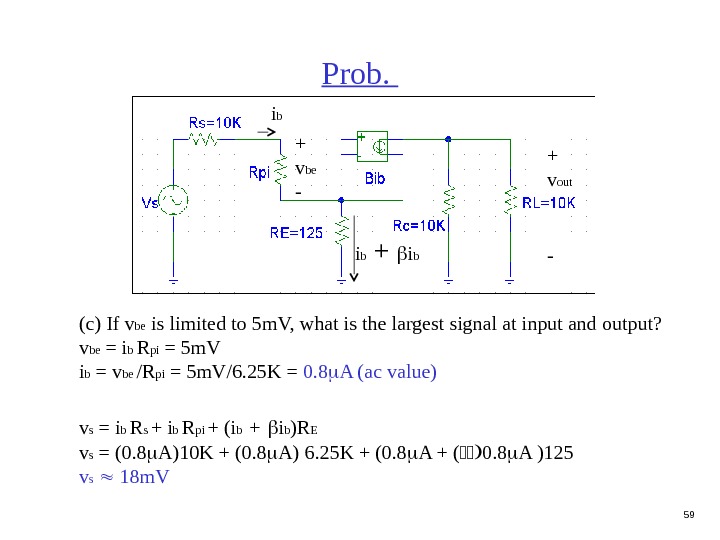
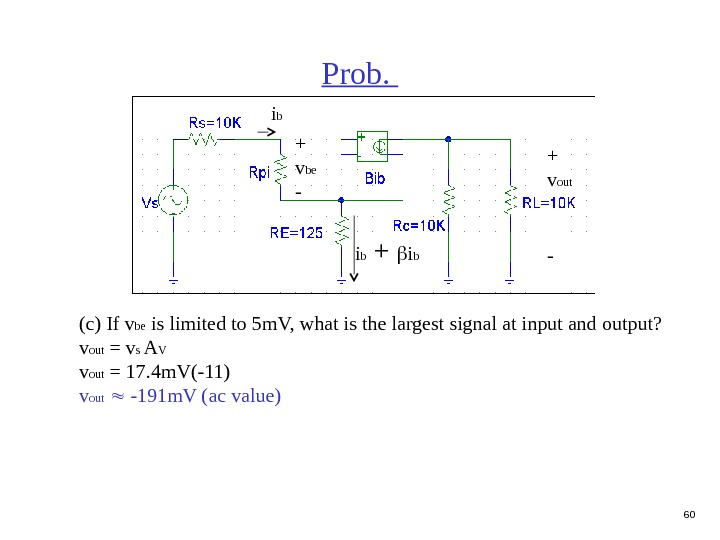

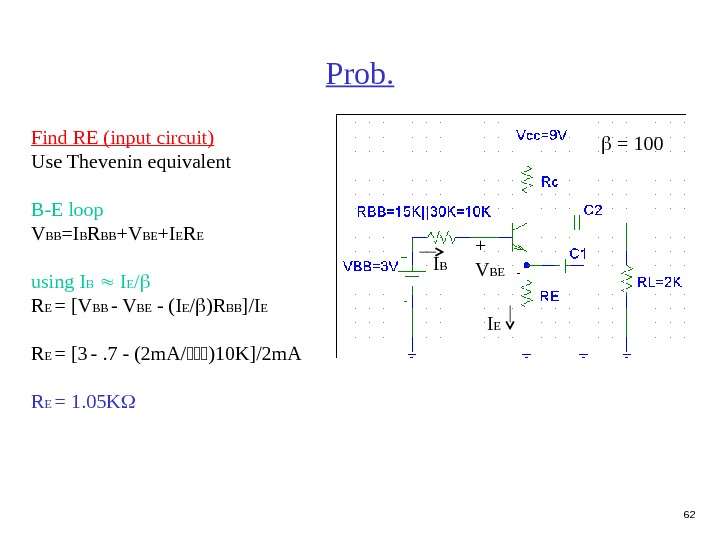
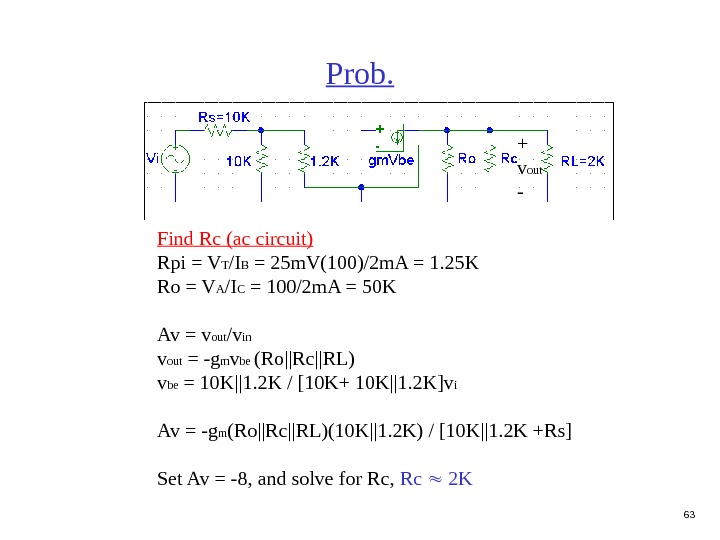
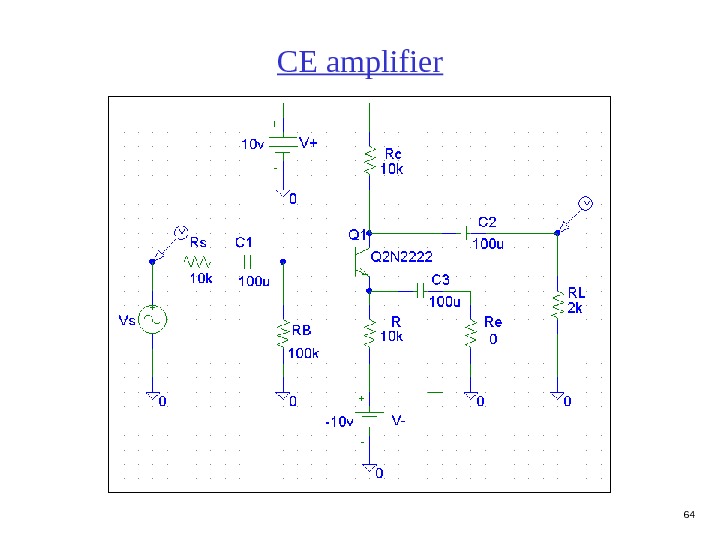
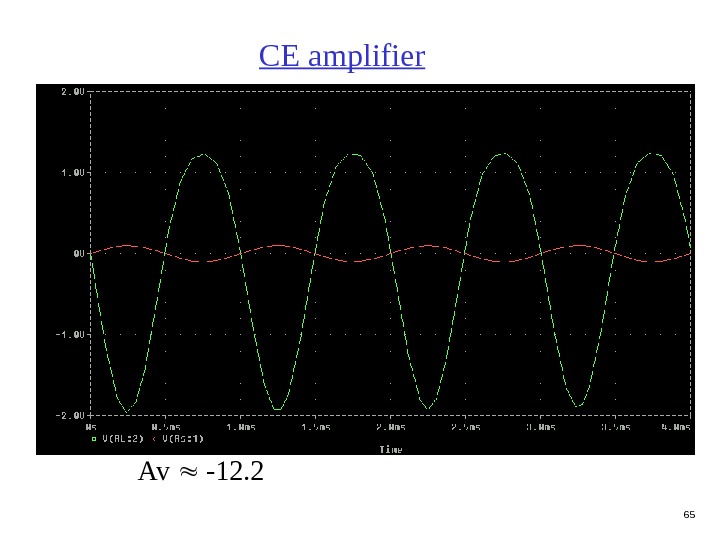


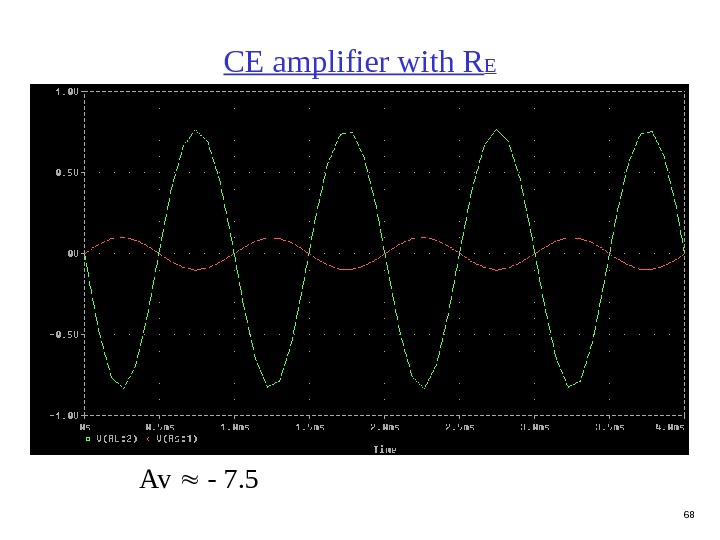

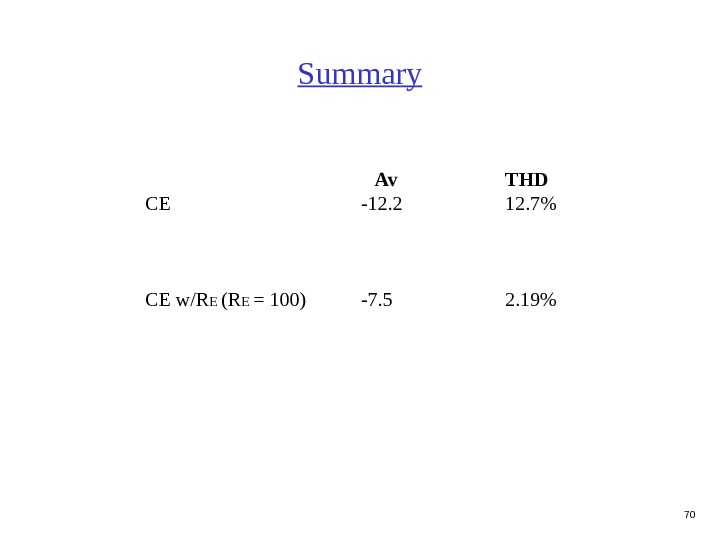
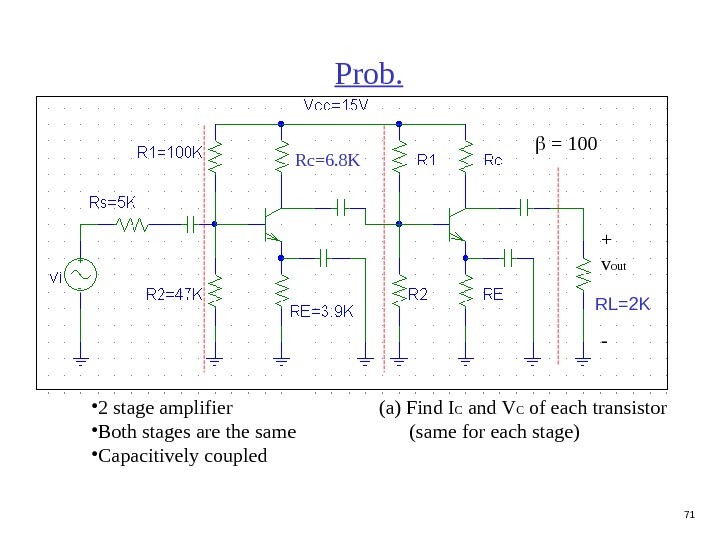
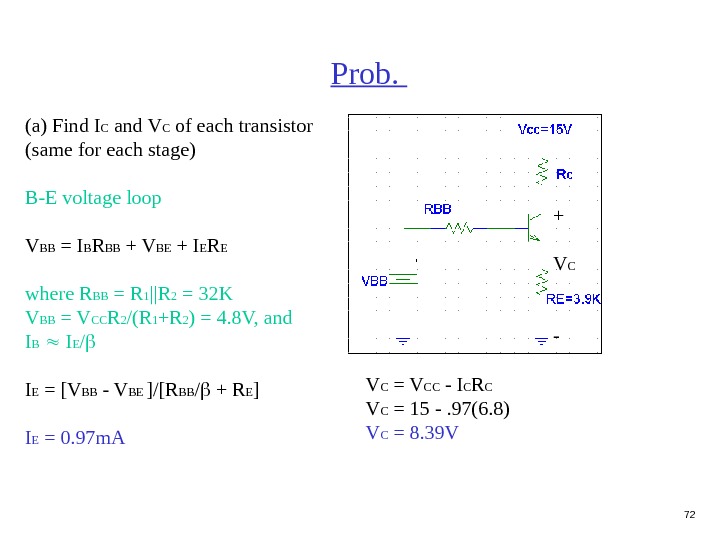
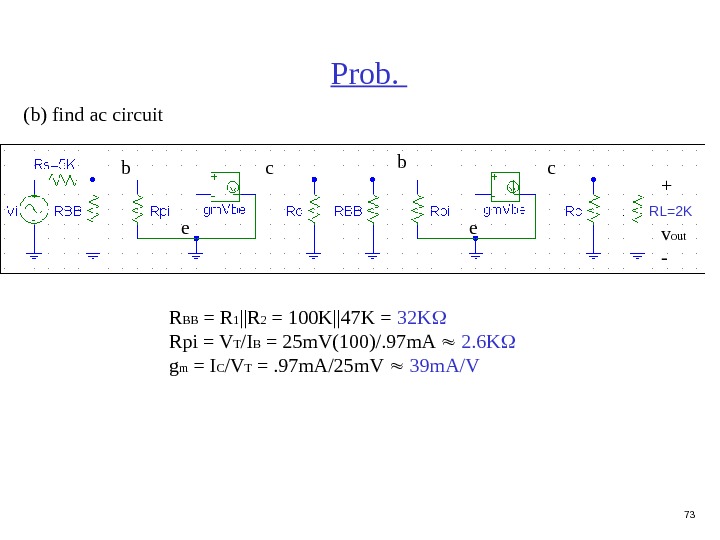
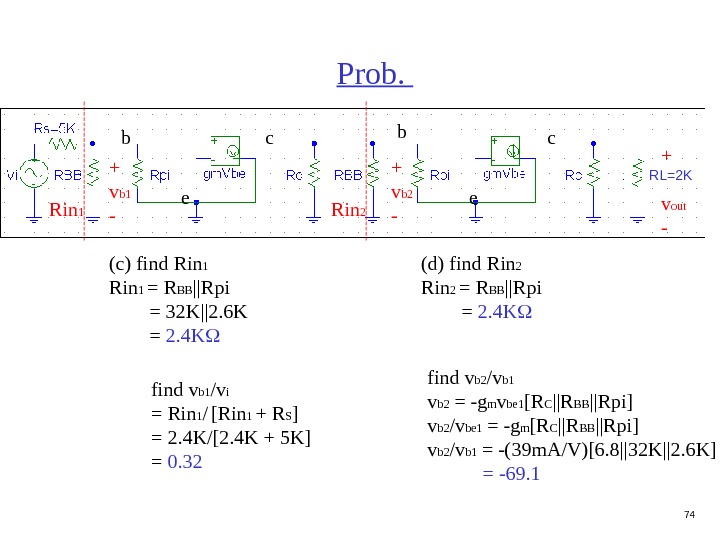
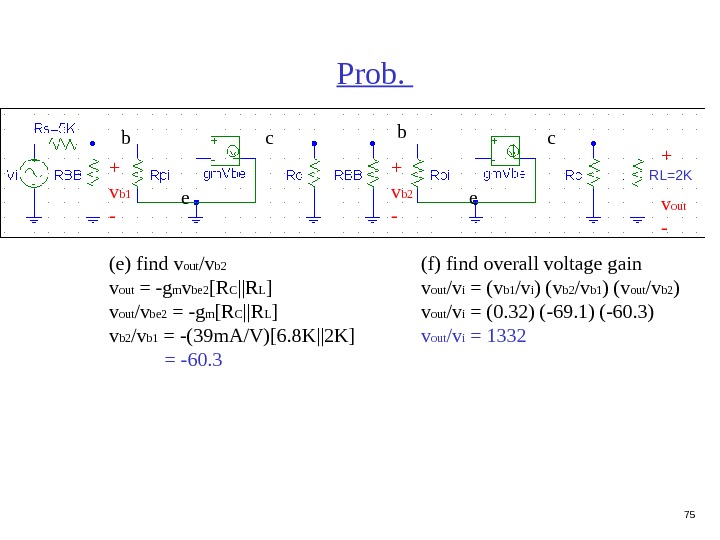
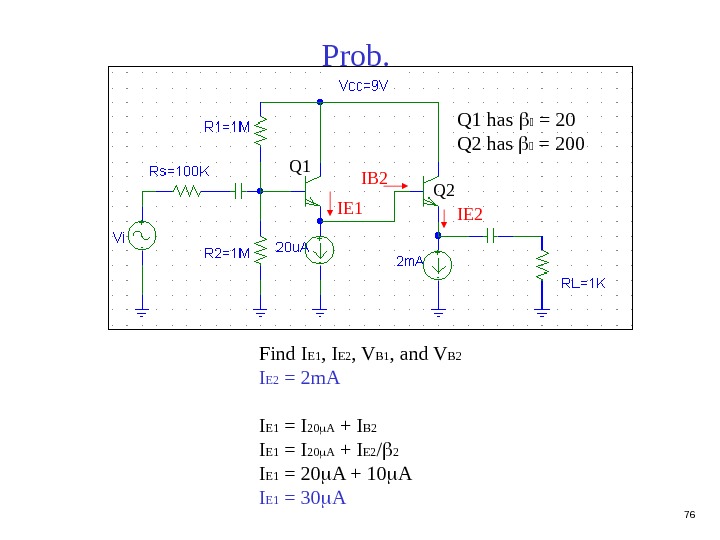
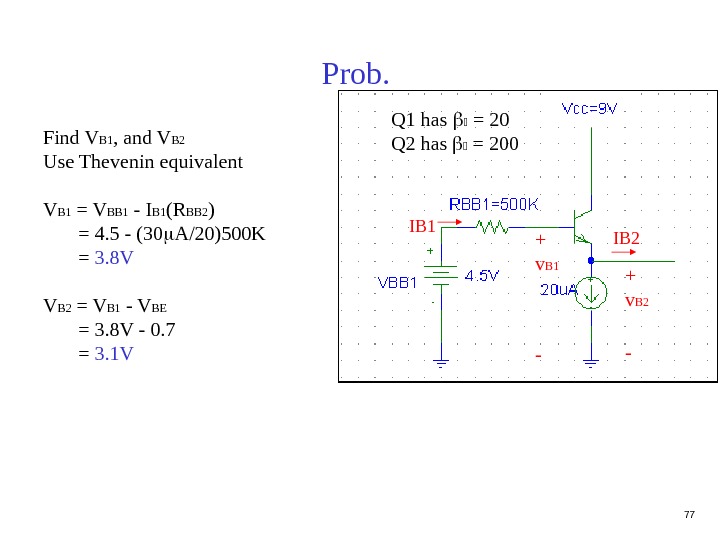
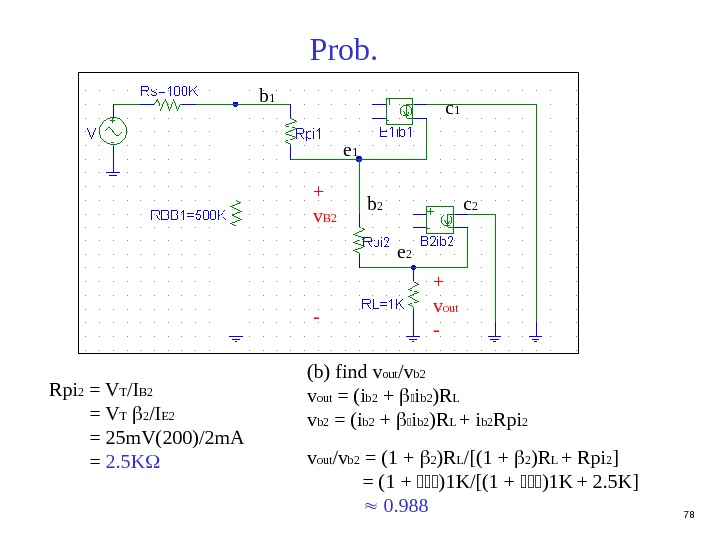
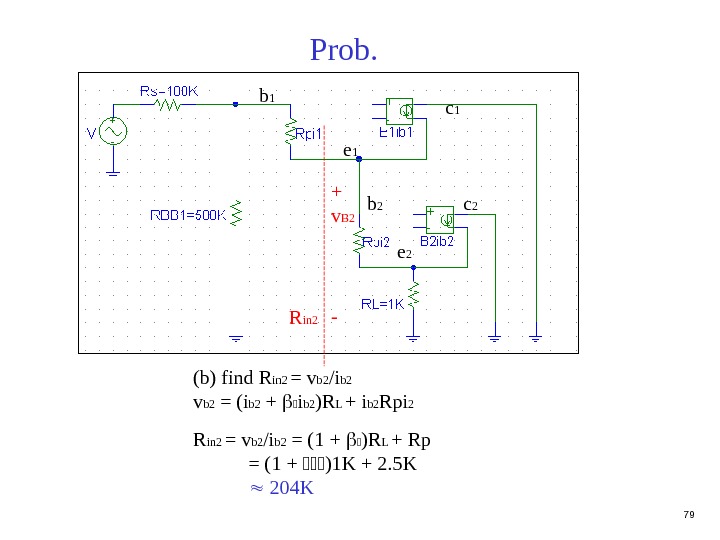
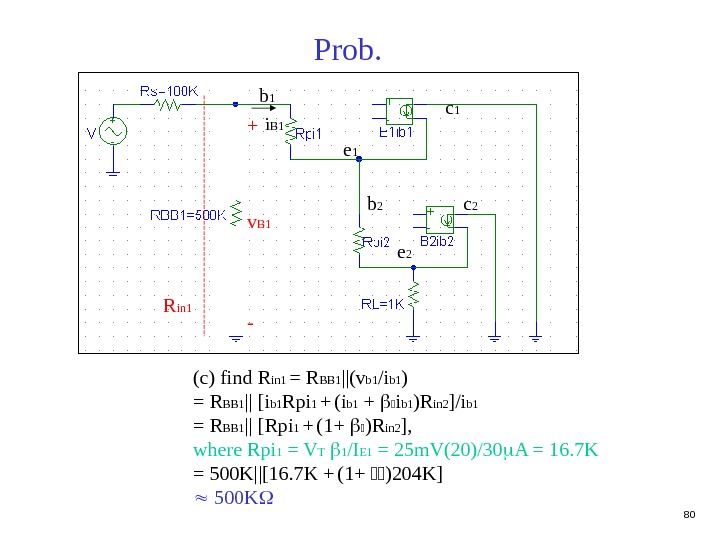
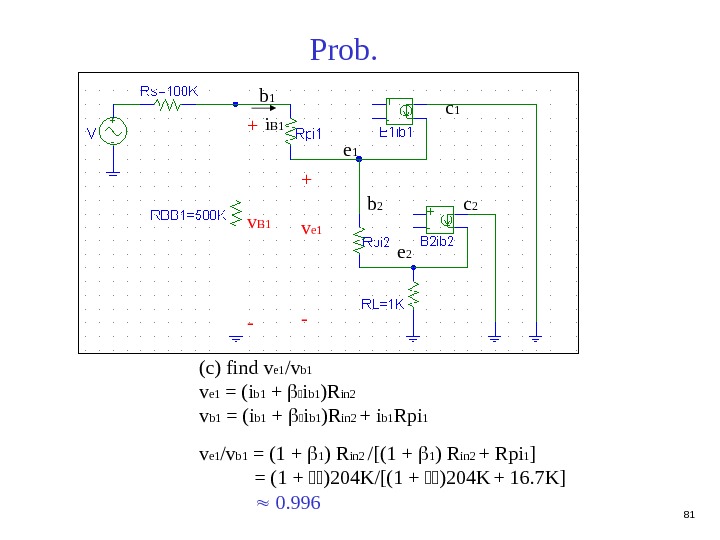
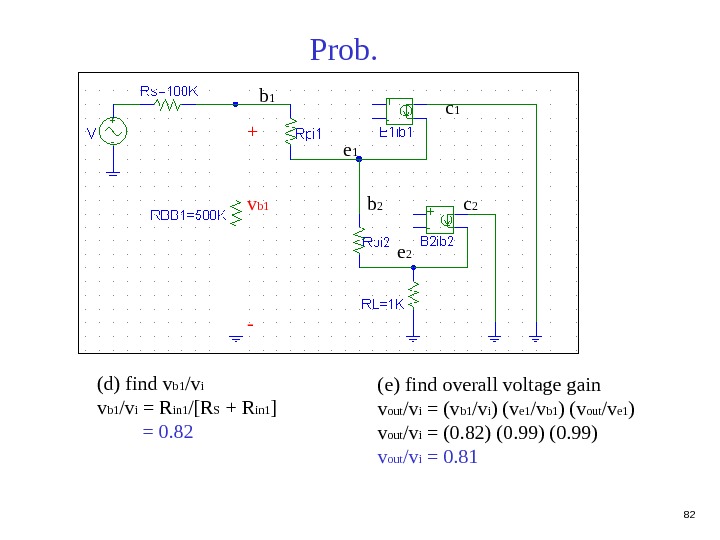
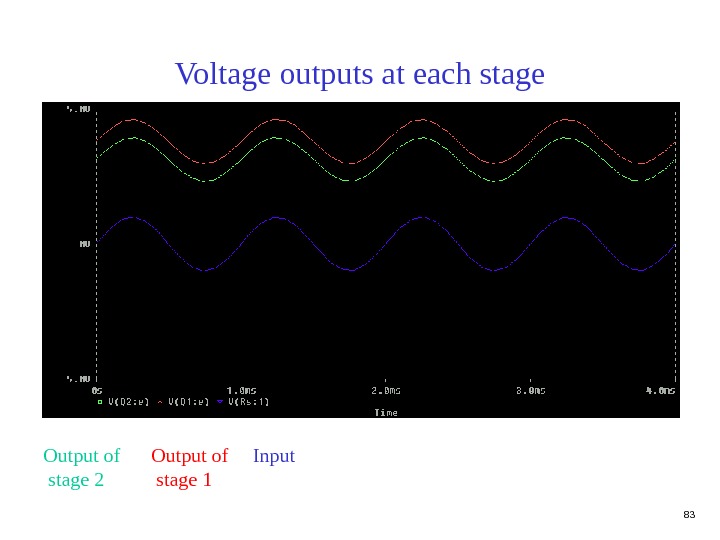
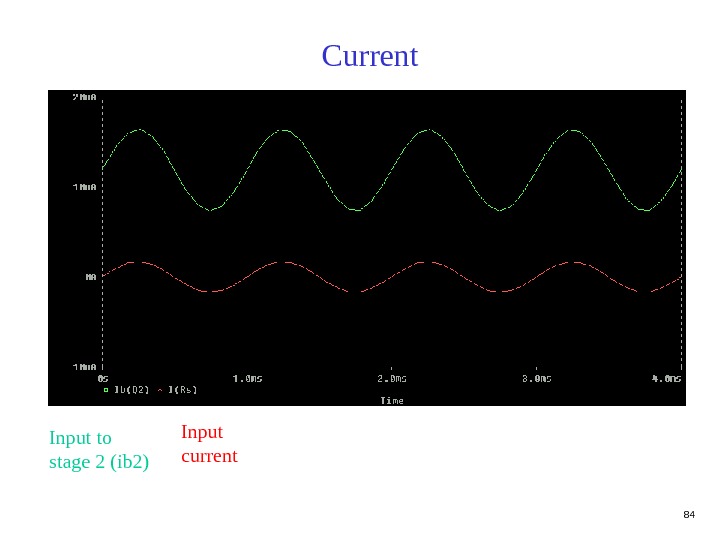
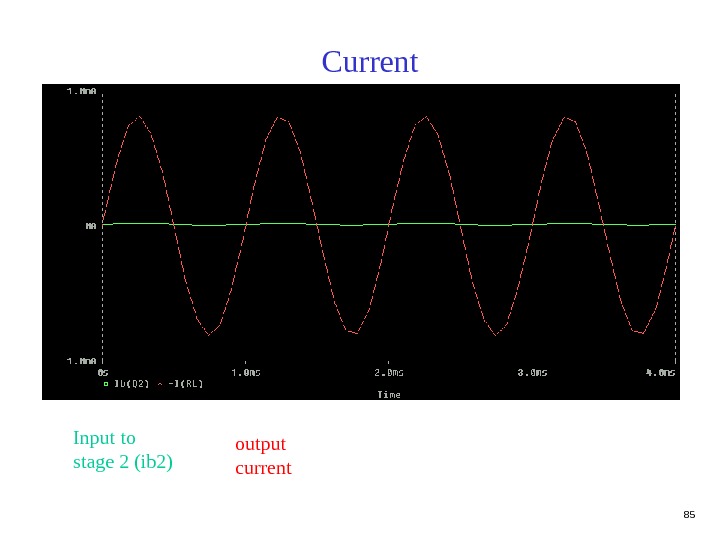
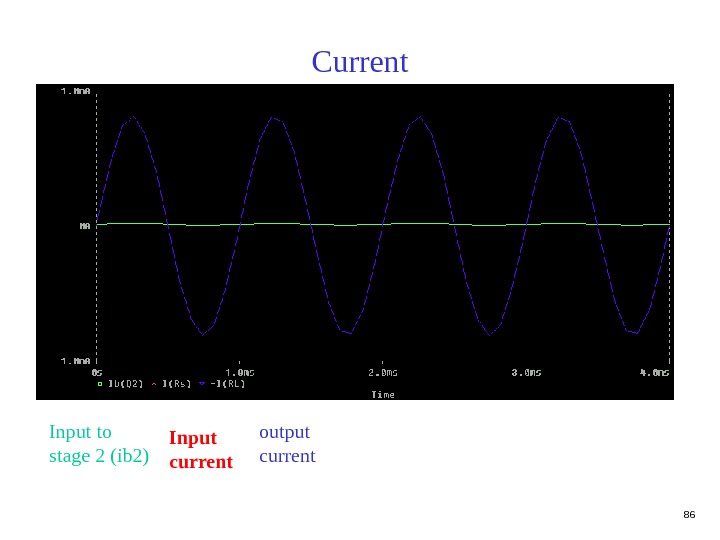
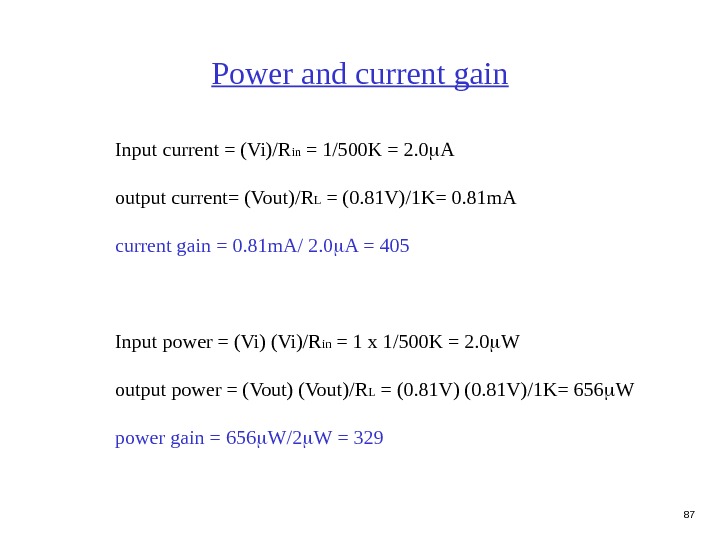
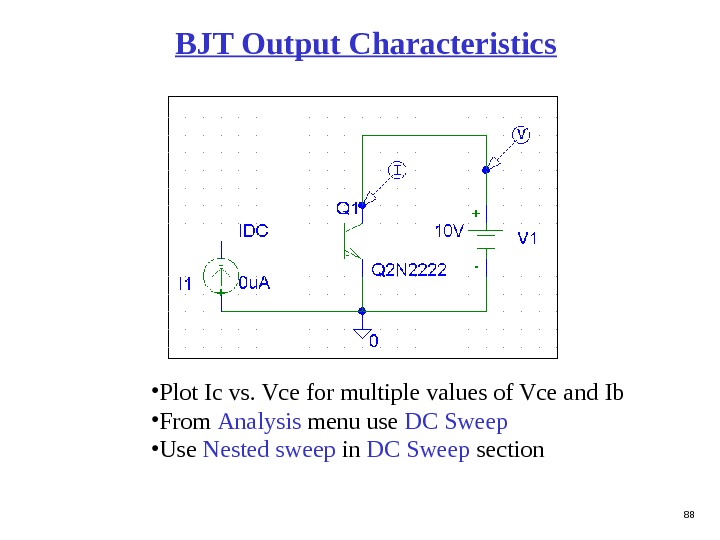
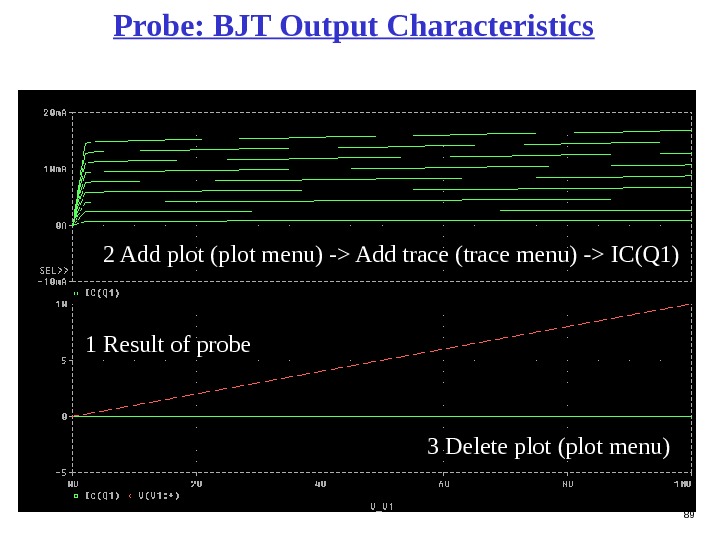
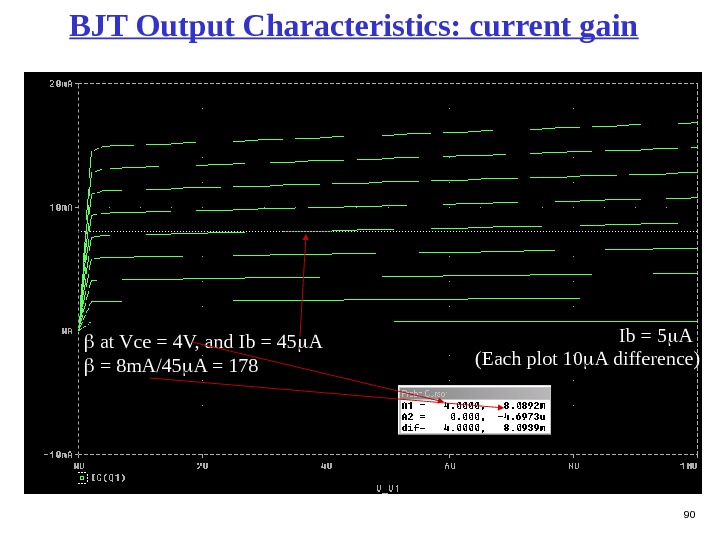
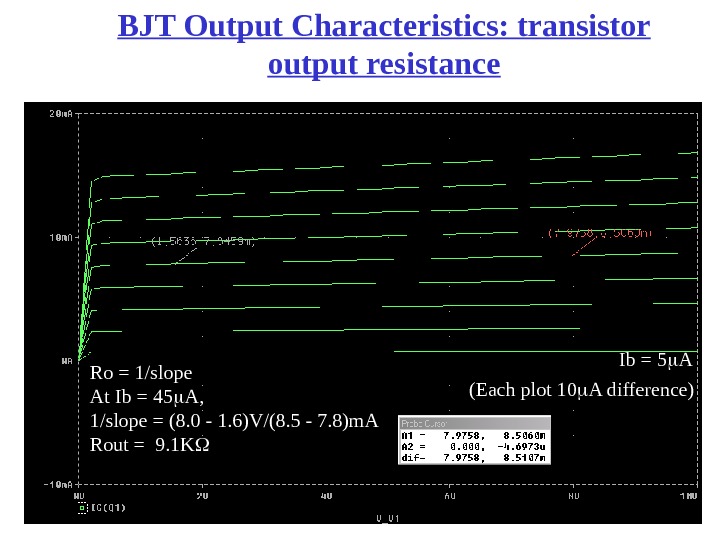
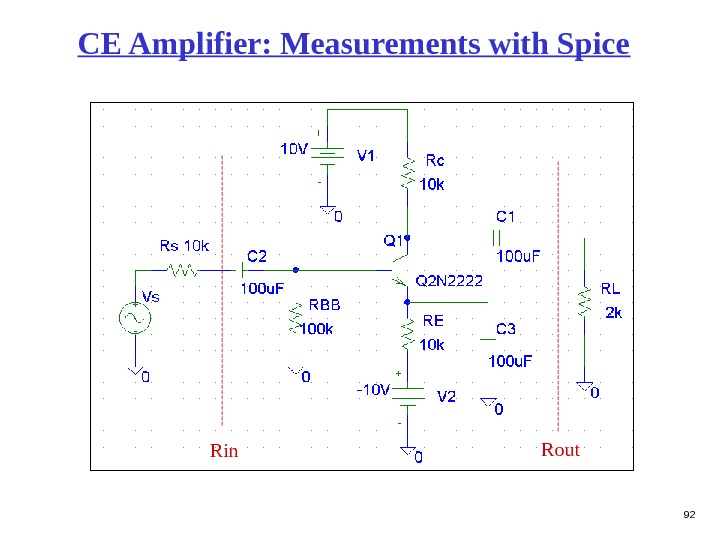
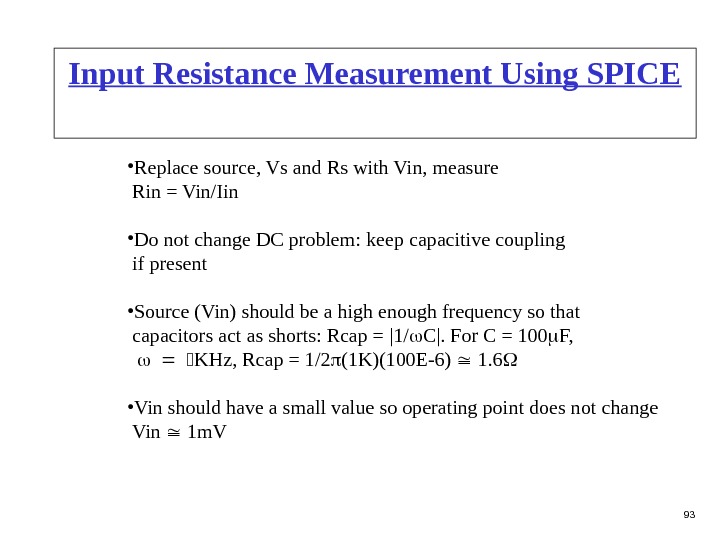
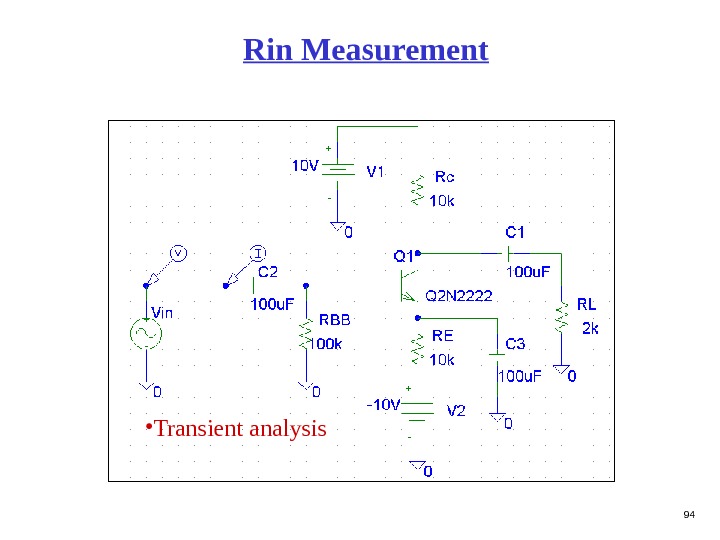
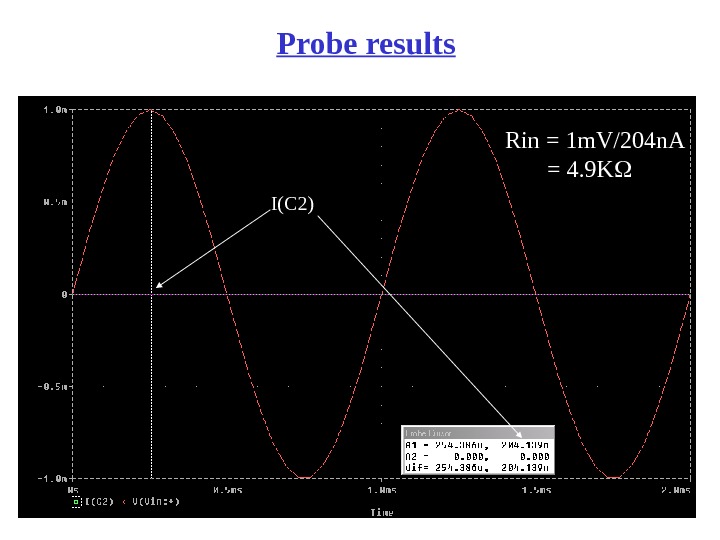
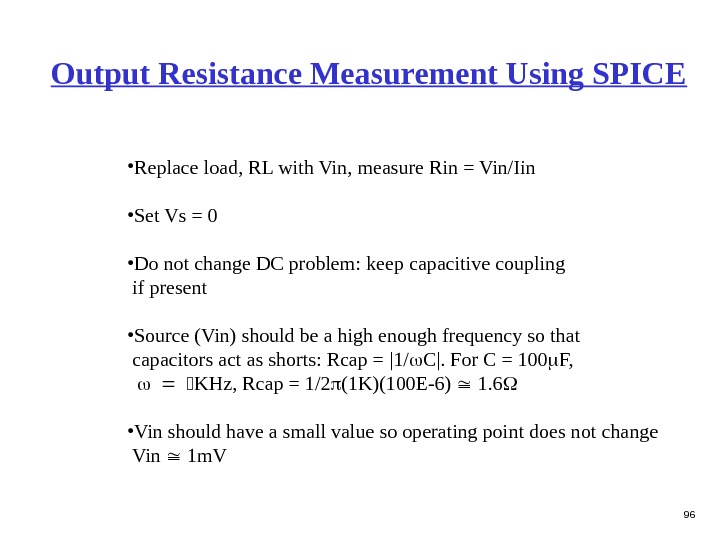
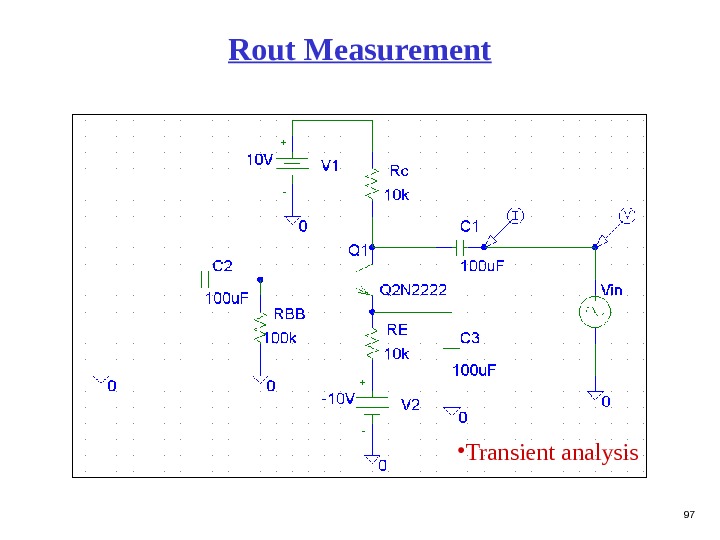
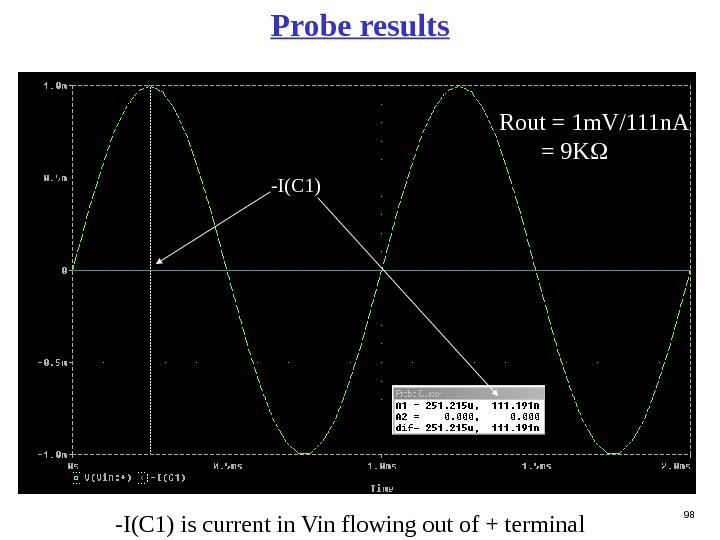
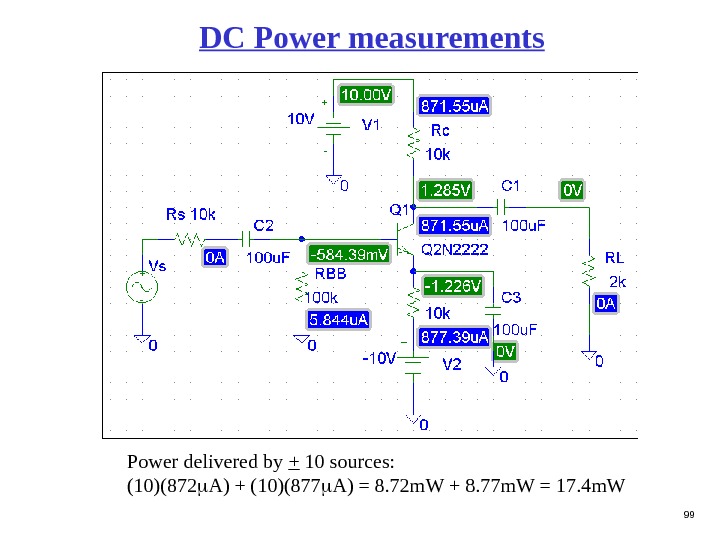
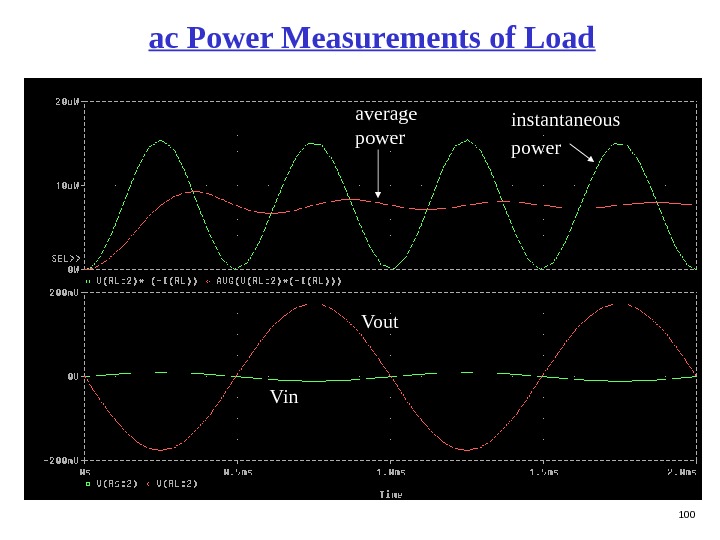
- Размер: 3.9 Mегабайта
- Количество слайдов: 100
Описание презентации 1 BJT Bipolar Junction Transistor по слайдам
 1 BJT Bipolar Junction Transistor • Widely used in amplifier circuits • Formed by junction of 3 materials • npn or pnp structure
1 BJT Bipolar Junction Transistor • Widely used in amplifier circuits • Formed by junction of 3 materials • npn or pnp structure
 2 pnp transistor
2 pnp transistor
 3 Large current. Operation of npn transistor
3 Large current. Operation of npn transistor
 4 Modes of operation of a BJT transistor Mode BE junction BC junction cutoff reverse biased linear(active) forward biased reverse biased saturation forward biased
4 Modes of operation of a BJT transistor Mode BE junction BC junction cutoff reverse biased linear(active) forward biased reverse biased saturation forward biased
 5 Summary of npn transistor behavior npn collector emitterbase I B I EI C small current large current + V BE —
5 Summary of npn transistor behavior npn collector emitterbase I B I EI C small current large current + V BE —
 6 Summary of pnp transistor behavior pnp collector emitterbase I B I EI C small current large current + V BE —
6 Summary of pnp transistor behavior pnp collector emitterbase I B I EI C small current large current + V BE —
 7 Summary of equations for a BJT I E I C = I B is the current gain of the transistor 100 V BE = 0. 7 V(npn) V BE = -0. 7 V(pnp)
7 Summary of equations for a BJT I E I C = I B is the current gain of the transistor 100 V BE = 0. 7 V(npn) V BE = -0. 7 V(pnp)
 8 Graphical representation of transistor characteristics I B I C I E Output circuit Input circuit
8 Graphical representation of transistor characteristics I B I C I E Output circuit Input circuit
 9 Input characteristics • Acts as a diode • V BE 0. 7 VI B V BE 0. 7 V
9 Input characteristics • Acts as a diode • V BE 0. 7 VI B V BE 0. 7 V
 10 Output characteristics I C V CEI B = 10 AI B = 20 AI B = 30 AI B = 40 A Cutoff region • At a fixed I B , I C is not dependent on V CE • Slope of output characteristics in linear region is near 0 (scale exaggerated) Early voltage
10 Output characteristics I C V CEI B = 10 AI B = 20 AI B = 30 AI B = 40 A Cutoff region • At a fixed I B , I C is not dependent on V CE • Slope of output characteristics in linear region is near 0 (scale exaggerated) Early voltage
 11 Biasing a transistor • We must operate the transistor in the linear region. • A transistor’s operating point (Q-point) is defined by I C , V CE , and I B.
11 Biasing a transistor • We must operate the transistor in the linear region. • A transistor’s operating point (Q-point) is defined by I C , V CE , and I B.
 12 A small ac signal v be is superimposed on the DC voltage V BE. It gives rise to a collector signal current i c , superimposed on the dc current I C. Transconductance ac input signal(DC input signal 0. 7 V) ac output signal DC output signal. I B The slope of the i c — v BE curve at the bias point Q is the transconductance g m : the amount of ac current produced by an ac voltage.
12 A small ac signal v be is superimposed on the DC voltage V BE. It gives rise to a collector signal current i c , superimposed on the dc current I C. Transconductance ac input signal(DC input signal 0. 7 V) ac output signal DC output signal. I B The slope of the i c — v BE curve at the bias point Q is the transconductance g m : the amount of ac current produced by an ac voltage.
 13 Analysis of transistor circuits at DC For all circuits: assume transistor operates in linear region write B-E voltage loop write C-E voltage loop Example -1 B-E junction acts like a diode V E = V B — V BE = 4 V — 0. 7 V = 3. 3 V I EI C I E = (V E — 0)/R E = 3. 3/3. 3 K = 1 m. A I C I E = 1 m. A V C = 10 — I C R C = 10 — 1(4. 7) = 5. 3 V
13 Analysis of transistor circuits at DC For all circuits: assume transistor operates in linear region write B-E voltage loop write C-E voltage loop Example -1 B-E junction acts like a diode V E = V B — V BE = 4 V — 0. 7 V = 3. 3 V I EI C I E = (V E — 0)/R E = 3. 3/3. 3 K = 1 m. A I C I E = 1 m. A V C = 10 — I C R C = 10 — 1(4. 7) = 5. 3 V
 14 Example-2 B-E Voltage loop 5 = I B R B + V BE, solve for I B = (5 — V BE )/R B = (5 -. 7)/100 k = 0. 043 m. A I C = I B = (100)0. 043 m. A = 4. 3 m. A V C = 10 — I C R C = 10 — 4. 3(2) = 1. 4 VI EI C I B =
14 Example-2 B-E Voltage loop 5 = I B R B + V BE, solve for I B = (5 — V BE )/R B = (5 -. 7)/100 k = 0. 043 m. A I C = I B = (100)0. 043 m. A = 4. 3 m. A V C = 10 — I C R C = 10 — 4. 3(2) = 1. 4 VI EI C I B =
 15 Exercise-3 V E = 0 -. 7 = -0. 7 V I EI C I B = 50 I E = (V E — -10)/R E = (-. 7 +10)/10 K = 0. 93 m. A I C I E = 0. 93 m. A I B = I B / m V C = 10 — I C R C = 10 -. 93(5) = 5. 35 V
15 Exercise-3 V E = 0 -. 7 = -0. 7 V I EI C I B = 50 I E = (V E — -10)/R E = (-. 7 +10)/10 K = 0. 93 m. A I C I E = 0. 93 m. A I B = I B / m V C = 10 — I C R C = 10 -. 93(5) = 5. 35 V
 16 Prob. • Use a voltage divider, R B 1 and R B 2 to bias V B to avoid two power supplies. • Make the current in the voltage divider about 10 times I B to simplify the analysis. Use V B = 3 V and I = 0. 2 m. A. I BI (a) R B 1 and R B 2 form a voltage divider. Assume I >> I B I = V CC /(R B 1 + R B 2 ) . 2 m. A = 9 /(R B 1 + R B 2 ) AND V B = V CC [R B 2 /(R B 1 + R B 2 )] 3 = 9 [R B 2 /(R B 1 + R B 2 )], Solve for R B 1 and R B 2. R B 1 = 30 K , and R B 2 = 15 K .
16 Prob. • Use a voltage divider, R B 1 and R B 2 to bias V B to avoid two power supplies. • Make the current in the voltage divider about 10 times I B to simplify the analysis. Use V B = 3 V and I = 0. 2 m. A. I BI (a) R B 1 and R B 2 form a voltage divider. Assume I >> I B I = V CC /(R B 1 + R B 2 ) . 2 m. A = 9 /(R B 1 + R B 2 ) AND V B = V CC [R B 2 /(R B 1 + R B 2 )] 3 = 9 [R B 2 /(R B 1 + R B 2 )], Solve for R B 1 and R B 2. R B 1 = 30 K , and R B 2 = 15 K .
 17 Prob. Find the operating point • Use the Thevenin equivalent circuit for the base • Makes the circuit simpler • V BB = V B = 3 V • R BB is measured with voltage sources grounded • R BB = R B 1 || R B 2 = 30 K 15 K . 10 K
17 Prob. Find the operating point • Use the Thevenin equivalent circuit for the base • Makes the circuit simpler • V BB = V B = 3 V • R BB is measured with voltage sources grounded • R BB = R B 1 || R B 2 = 30 K 15 K . 10 K
 18 Prob. Write B-E loop and C-E loop B-E loop V BB = I B R BB + V BE +I E R E I E =2. 09 m. A C-E loop V CC = I C R C + V CE +I E R E V CE =4. 8 V This is how all DC circuits are analyzed and designed!
18 Prob. Write B-E loop and C-E loop B-E loop V BB = I B R BB + V BE +I E R E I E =2. 09 m. A C-E loop V CC = I C R C + V CE +I E R E V CE =4. 8 V This is how all DC circuits are analyzed and designed!
 19 Exercise-4 (a) Find V C , V B , and V E , given: = 100, V A = 100 V I E = 1 m. A I B I E / = 0. 01 m. A V B = 0 — I B 10 K = -0. 1 V V E = V B — V BE = -0. 1 — 0. 7 = -0. 8 V V C = 10 V — I C 8 K = 10 — 1(8) = 2 VV
19 Exercise-4 (a) Find V C , V B , and V E , given: = 100, V A = 100 V I E = 1 m. A I B I E / = 0. 01 m. A V B = 0 — I B 10 K = -0. 1 V V E = V B — V BE = -0. 1 — 0. 7 = -0. 8 V V C = 10 V — I C 8 K = 10 — 1(8) = 2 VV
 20 Example-5 • 2 -stage amplifier, 1 st stage has an npn transistor; 2 nd stage has an pnp transistor. I C = I B I C I E V BE = 0. 7 (npn) = -0. 7 (pnp) = 100 Find I C 1 , I C 2 , V CE 1 , V CE 2 • Use Thevenin circuits.
20 Example-5 • 2 -stage amplifier, 1 st stage has an npn transistor; 2 nd stage has an pnp transistor. I C = I B I C I E V BE = 0. 7 (npn) = -0. 7 (pnp) = 100 Find I C 1 , I C 2 , V CE 1 , V CE 2 • Use Thevenin circuits.
 21 Example -5 • R BB 1 = R B 1 ||R B 2 = 33 K • V BB 1 = V CC [R B 2 /(R B 1 +R B 2 )] V BB 1 = 15[50 K/150 K] = 5 V Stage 1 • B-E loop V BB 1 = I B 1 R BB 1 + V BE +I E 1 R E 1 Use I B 1 I E 1 / 5 = I E 1 33 K / 100 +. 7 + I E 1 3 K I E 1 = 1. 3 m. AI B 1 I
21 Example -5 • R BB 1 = R B 1 ||R B 2 = 33 K • V BB 1 = V CC [R B 2 /(R B 1 +R B 2 )] V BB 1 = 15[50 K/150 K] = 5 V Stage 1 • B-E loop V BB 1 = I B 1 R BB 1 + V BE +I E 1 R E 1 Use I B 1 I E 1 / 5 = I E 1 33 K / 100 +. 7 + I E 1 3 K I E 1 = 1. 3 m. AI B 1 I
 22 Example -5 C-E loop neglect IB 2 because it is IB 2 << IC 1 I E 1 I C 1 V CC = I C 1 R C 1 + V CE 1 +I E 1 R E 1 15 = 1. 3(5) + V CE 1 +1. 3(3) V CE 1 = 4. 87 V
22 Example -5 C-E loop neglect IB 2 because it is IB 2 << IC 1 I E 1 I C 1 V CC = I C 1 R C 1 + V CE 1 +I E 1 R E 1 15 = 1. 3(5) + V CE 1 +1. 3(3) V CE 1 = 4. 87 V
 23 Example-5 Stage 2 • B-E loop I B 2 I E 2 V CC = I E 2 R E 2 + V EB +I B 2 R BB 2 + V BB 2 15 = I E 2 (2 K) +. 7 +I B 2 (5 K) + 4. 87 + 1. 3(3) Use I B 2 I E 2 / solve for I E 2 = 2. 8 m.
23 Example-5 Stage 2 • B-E loop I B 2 I E 2 V CC = I E 2 R E 2 + V EB +I B 2 R BB 2 + V BB 2 15 = I E 2 (2 K) +. 7 +I B 2 (5 K) + 4. 87 + 1. 3(3) Use I B 2 I E 2 / solve for I E 2 = 2. 8 m.
 24 Example-5 Stage 2 • C-E loop I E 2 I C 2 V CC = I E 2 R E 2 + V EC 2 +I C 2 R C 2 15 = 2. 8(2) + V EC 2 + 2. 8 (2. 7) solve for V EC 2 V CE 2 = 1. 84 V
24 Example-5 Stage 2 • C-E loop I E 2 I C 2 V CC = I E 2 R E 2 + V EC 2 +I C 2 R C 2 15 = 2. 8(2) + V EC 2 + 2. 8 (2. 7) solve for V EC 2 V CE 2 = 1. 84 V
 25 Summary of DC problem • Bias transistors so that they operate in the linear region B-E junction forward biased, C-E junction reversed biased • Use V BE = 0. 7 (npn), I C I E , I C = I B • Represent base portion of circuit by the Thevenin circuit • Write B-E, and C-E voltage loops. • For analysis, solve for I C , and V CE. • For design, solve for resistor values (I C and V CE specified).
25 Summary of DC problem • Bias transistors so that they operate in the linear region B-E junction forward biased, C-E junction reversed biased • Use V BE = 0. 7 (npn), I C I E , I C = I B • Represent base portion of circuit by the Thevenin circuit • Write B-E, and C-E voltage loops. • For analysis, solve for I C , and V CE. • For design, solve for resistor values (I C and V CE specified).
 26 Summary of npn transistor behavior npn collector emitterbase I B I EI C small current large current + V BE —
26 Summary of npn transistor behavior npn collector emitterbase I B I EI C small current large current + V BE —
 27 Transistor as an amplifier • Transistor circuits are analyzed and designed in terms of DC and ac versions of the same circuit. • An ac signal is usually superimposed on the DC circuit. • The location of the operating point (values of I C and V CE ) of the transistor affects the ac operation of the circuit. • There at least two ac parameters determined from DC quantities.
27 Transistor as an amplifier • Transistor circuits are analyzed and designed in terms of DC and ac versions of the same circuit. • An ac signal is usually superimposed on the DC circuit. • The location of the operating point (values of I C and V CE ) of the transistor affects the ac operation of the circuit. • There at least two ac parameters determined from DC quantities.
 28 A small ac signal v be is superimposed on the DC voltage V BE. It gives rise to a collector signal current i c , superimposed on the dc current I C. Transconductance ac input signal(DC input signal 0. 7 V) ac output signal DC output signal. I B The slope of the i c — v BE curve at the bias point Q is the transconductance g m : the amount of ac current produced by an ac voltage.
28 A small ac signal v be is superimposed on the DC voltage V BE. It gives rise to a collector signal current i c , superimposed on the dc current I C. Transconductance ac input signal(DC input signal 0. 7 V) ac output signal DC output signal. I B The slope of the i c — v BE curve at the bias point Q is the transconductance g m : the amount of ac current produced by an ac voltage.
 29 Transconductance = slope at Q point g m = d i c /d v BE | i c = I CQ where I C = I S [exp(-V BE /V T )-1]; the equation for a diode. Transconductance ac input signal. DC input signal (0. 7 V) ac output signal DC output signal g m = I S exp(-V BE /V T ) (1/V T ) g m I C /V T (A/V)
29 Transconductance = slope at Q point g m = d i c /d v BE | i c = I CQ where I C = I S [exp(-V BE /V T )-1]; the equation for a diode. Transconductance ac input signal. DC input signal (0. 7 V) ac output signal DC output signal g m = I S exp(-V BE /V T ) (1/V T ) g m I C /V T (A/V)
 30 ac input resistance 1/slope at Q point r = d v BE /d i b | i c = I CQ r V T /I B r e V T /I E ac input resistance of transistor ac input signal. DC input signal (0. 7 V) ac output signal DC output signal. I
30 ac input resistance 1/slope at Q point r = d v BE /d i b | i c = I CQ r V T /I B r e V T /I E ac input resistance of transistor ac input signal. DC input signal (0. 7 V) ac output signal DC output signal. I
 31 Small-signal equivalent circuit models • ac model • Hybrid- model • They are equivalent • Works in linear region only
31 Small-signal equivalent circuit models • ac model • Hybrid- model • They are equivalent • Works in linear region only
 32 Steps to analyze a transistor circuit 1 DC problem Set ac sources to zero, solve for DC quantities, I C and V CE. 2 Determine ac quantities from DC parameters Find g m , r and r e. 3 ac problem Set DC sources to zero, replace transistor by hybrid- model, find ac quantites, Rin, Rout, Av, and Ai.
32 Steps to analyze a transistor circuit 1 DC problem Set ac sources to zero, solve for DC quantities, I C and V CE. 2 Determine ac quantities from DC parameters Find g m , r and r e. 3 ac problem Set DC sources to zero, replace transistor by hybrid- model, find ac quantites, Rin, Rout, Av, and Ai.
 33 Example-6 Find v out /v in , ( = 100) DC problem Short v i , determine I C and V CE B-E voltage loop 3 = I B R B + V BE I B = (3 -. 7)/R B = 0. 023 m. A C-E voltage loop V CE = 10 — I C R C V CE = 10 — (2. 3)(3) V CE = 3. 1 V Q point: V CE = 3. 1 V, I C = 2. 3 m.
33 Example-6 Find v out /v in , ( = 100) DC problem Short v i , determine I C and V CE B-E voltage loop 3 = I B R B + V BE I B = (3 -. 7)/R B = 0. 023 m. A C-E voltage loop V CE = 10 — I C R C V CE = 10 — (2. 3)(3) V CE = 3. 1 V Q point: V CE = 3. 1 V, I C = 2. 3 m.
 34 Example -6 ac problem Short DC sources, input and output circuits are separate, only coupled mathematically g m = I C /V T = 2. 3 m. A/25 m. V = 92 m. A/V r = V T / I B = 25 m. V/. 023 m. A = 1. 1 K v be = v i [ r / (100 K + r 011 v i v out = — g m v be R C v out = — 92 ( 011 v i ) 3 K v out /v i = -3. 04 + v out — eb c + v be —
34 Example -6 ac problem Short DC sources, input and output circuits are separate, only coupled mathematically g m = I C /V T = 2. 3 m. A/25 m. V = 92 m. A/V r = V T / I B = 25 m. V/. 023 m. A = 1. 1 K v be = v i [ r / (100 K + r 011 v i v out = — g m v be R C v out = — 92 ( 011 v i ) 3 K v out /v i = -3. 04 + v out — eb c + v be —
 35 Exercise-7 Find g m , r , and r , given: = 100, V A = 100 V, I C =1 m. A g m = I C /V T = 1 m. A/25 m. V = 40 m. A/V r = V T / I B = 25 m. V/. 01 m. A = 2. 5 K r 0 = output resistance of transistor r 0 = 1/slope of transistor output characteristics r 0 = | V A |/I C = 100 K
35 Exercise-7 Find g m , r , and r , given: = 100, V A = 100 V, I C =1 m. A g m = I C /V T = 1 m. A/25 m. V = 40 m. A/V r = V T / I B = 25 m. V/. 01 m. A = 2. 5 K r 0 = output resistance of transistor r 0 = 1/slope of transistor output characteristics r 0 = | V A |/I C = 100 K
 36 Summary of transistor analysis • Transistor circuits are analyzed and designed in terms of DC and ac versions of the same circuit. • An ac signal is usually superimposed on the DC circuit. • The location of the operating point (values of I C and V CE ) of the transistor affects the ac operation of the circuit. • There at least two ac parameters determined from DC quantities.
36 Summary of transistor analysis • Transistor circuits are analyzed and designed in terms of DC and ac versions of the same circuit. • An ac signal is usually superimposed on the DC circuit. • The location of the operating point (values of I C and V CE ) of the transistor affects the ac operation of the circuit. • There at least two ac parameters determined from DC quantities.
 37 Steps to analyze a transistor circuit 1 DC Analysis Set ac sources to zero, solve for DC quantities, I C and V CE. 2 Determine ac quantities from DC parameters Find g m , r and r o. 3 AC Analysis Set DC sources to zero, replace transistor by hybrid- model, find ac quantities, Rin, Rout, Av, and Ai. r o
37 Steps to analyze a transistor circuit 1 DC Analysis Set ac sources to zero, solve for DC quantities, I C and V CE. 2 Determine ac quantities from DC parameters Find g m , r and r o. 3 AC Analysis Set DC sources to zero, replace transistor by hybrid- model, find ac quantities, Rin, Rout, Av, and Ai. r o
 38 Circuit I E = 1 m. A V C = 10 V — I C 8 K = 10 — 1(8) = 2 V I B I E / = 0. 01 m. A g m = I C /V T = 1 m. A/25 m. V = 40 m. A/V V B = 0 — I B 10 K = -0. 1 V r = V T / I B = 25 m. V/. 01 m. A = 2. 5 K V E = V B — V BE = -0. 1 — 0. 7 = -0. 8 V + V out —
38 Circuit I E = 1 m. A V C = 10 V — I C 8 K = 10 — 1(8) = 2 V I B I E / = 0. 01 m. A g m = I C /V T = 1 m. A/25 m. V = 40 m. A/V V B = 0 — I B 10 K = -0. 1 V r = V T / I B = 25 m. V/. 01 m. A = 2. 5 K V E = V B — V BE = -0. 1 — 0. 7 = -0. 8 V + V out —
 39 ac equivalent circuit b e c v be = (R b ||R pi )/ [(R b ||R pi ) +R s ]v i v be = 0. 5 v i v out = -(g m v be )||(R o ||R c ||R L ) v out = -154 v be A v = v out /v i = — 77 + v out — Neglecting R o v out = -(g m v be )||(R c ||R L ) A v = v out /v i = —
39 ac equivalent circuit b e c v be = (R b ||R pi )/ [(R b ||R pi ) +R s ]v i v be = 0. 5 v i v out = -(g m v be )||(R o ||R c ||R L ) v out = -154 v be A v = v out /v i = — 77 + v out — Neglecting R o v out = -(g m v be )||(R c ||R L ) A v = v out /v i = —
 40 Prob. + V out — =
40 Prob. + V out — =
 41 Prob. + V out — (a) Find R in = R pi = V T /I B = (25 m. V)100/. 1 = 2. 5 K (c) Find R out = R c = 47 K R in R out (b) Find A v = v out /v in v out = — i b R c v in = i b (R + R pi) A v = v out /v in = — i b R c / i b (R + R pi = — R c /(R + R pi) = — (47 K)/(100 K + 2. 5 K) = — = ibb e c i b
41 Prob. + V out — (a) Find R in = R pi = V T /I B = (25 m. V)100/. 1 = 2. 5 K (c) Find R out = R c = 47 K R in R out (b) Find A v = v out /v in v out = — i b R c v in = i b (R + R pi) A v = v out /v in = — i b R c / i b (R + R pi = — R c /(R + R pi) = — (47 K)/(100 K + 2. 5 K) = — = ibb e c i b
 42 Graphical analysis Input circuit B-E voltage loop V BB = I B R B +V BE I B = (V BB — V BE )/R
42 Graphical analysis Input circuit B-E voltage loop V BB = I B R B +V BE I B = (V BB — V BE )/R
 43 Graphical construction of I B and V BE I B = (V BB — V BE )/R B If V BE = 0 , I B = V BB /R B If I B = 0 , V BE = V BB /R
43 Graphical construction of I B and V BE I B = (V BB — V BE )/R B If V BE = 0 , I B = V BB /R B If I B = 0 , V BE = V BB /R
 44 Load line Output circuit C-E voltage loop V CC = I C R C +V CE I C = (V CC — V CE )/R
44 Load line Output circuit C-E voltage loop V CC = I C R C +V CE I C = (V CC — V CE )/R
 45 Graphical construction of I C and V CE V CC /R C I C = (V CC — V CE )/R C If V CE = 0 , I C = V CC /R C If I C = 0 , V CE = V
45 Graphical construction of I C and V CE V CC /R C I C = (V CC — V CE )/R C If V CE = 0 , I C = V CC /R C If I C = 0 , V CE = V
 46 Graphical analysis Input signal Output signal
46 Graphical analysis Input signal Output signal
 47 • Load-line A results in bias point Q A which is too close to V CC and thus limits the positive swing of v CE. • Load-line B results in an operating point too close to the saturation region, thus limiting the negative swing of v CE. Bias point location effects
47 • Load-line A results in bias point Q A which is too close to V CC and thus limits the positive swing of v CE. • Load-line B results in an operating point too close to the saturation region, thus limiting the negative swing of v CE. Bias point location effects
 48 Basic single-stage BJT amplifier configurations We will study 3 types of BJT amplifiers • CE — common emitter, used for A V , A i , and general purpose • CE with R E — common emitter with R E , same as CE but more stable • CC common collector, used for A i , low output resistance, used as an output stage CB common base (not covered)
48 Basic single-stage BJT amplifier configurations We will study 3 types of BJT amplifiers • CE — common emitter, used for A V , A i , and general purpose • CE with R E — common emitter with R E , same as CE but more stable • CC common collector, used for A i , low output resistance, used as an output stage CB common base (not covered)
 49 Common emitter amplifier ac equivalent circuit
49 Common emitter amplifier ac equivalent circuit
 50 Common emitter amplifier R in R out+ V out -R in (Does not include source) R in = R pi R out (Does not include load) R out = R C A V = V out /V in V out = — i b R C V in = i b (R s + R pi ) A V = — R C / (R s + R pi ) A i = i out /i in i out = — i b i in = i b A i = — i b i out
50 Common emitter amplifier R in R out+ V out -R in (Does not include source) R in = R pi R out (Does not include load) R out = R C A V = V out /V in V out = — i b R C V in = i b (R s + R pi ) A V = — R C / (R s + R pi ) A i = i out /i in i out = — i b i in = i b A i = — i b i out
 51 Common emitter with R E amplifier ac equivalent circuit
51 Common emitter with R E amplifier ac equivalent circuit
 52 Common emitter with R E amplifier R in R out + V out -R in = V/i b V = i b R pi + (i b + i b )R E R in = R pi + (1 + )R E (usually large) R out = R C A V = V out /V in V out = — i b R C V in = i b R s + i b R pi + (i b + i b )R E A V = — R C / (R s + R pi + (1 + )R E ) (less than CE, but less sensitive to variations) A i = i out /i in i out = — i b i in = i b A i = — i b i out i b + i b+ V —
52 Common emitter with R E amplifier R in R out + V out -R in = V/i b V = i b R pi + (i b + i b )R E R in = R pi + (1 + )R E (usually large) R out = R C A V = V out /V in V out = — i b R C V in = i b R s + i b R pi + (i b + i b )R E A V = — R C / (R s + R pi + (1 + )R E ) (less than CE, but less sensitive to variations) A i = i out /i in i out = — i b i in = i b A i = — i b i out i b + i b+ V —
 53 Common collector (emitter follower) amplifier b c e + v out — (v out at emitter) ac equivalent circuit
53 Common collector (emitter follower) amplifier b c e + v out — (v out at emitter) ac equivalent circuit
 54 Common collector amplifier R in + v out -R in = V/i b V = i b R pi + (i b + i b )R L R in = R pi + (1 + )R L A V = v out /v s v out = (i b + i b )R L v s = i b R s + i b R pi + (i b + i b )R L A V = (1+ R L / (R s + R pi + (1 + )R L ) (always < 1)i b + i b+ V —
54 Common collector amplifier R in + v out -R in = V/i b V = i b R pi + (i b + i b )R L R in = R pi + (1 + )R L A V = v out /v s v out = (i b + i b )R L v s = i b R s + i b R pi + (i b + i b )R L A V = (1+ R L / (R s + R pi + (1 + )R L ) (always < 1)i b + i b+ V —
 55 Common collector amplifier R out+ v out — R out (don’t include RL, set Vs = 0) R out = v out /- ( i b + i b ) v out = -i b R pi + -i b R s R out = (R pi + R s ) / (1+ (usually low)A i = i out /i in i out = i b + i b i in = i b A i = i b + i b
55 Common collector amplifier R out+ v out — R out (don’t include RL, set Vs = 0) R out = v out /- ( i b + i b ) v out = -i b R pi + -i b R s R out = (R pi + R s ) / (1+ (usually low)A i = i out /i in i out = i b + i b i in = i b A i = i b + i b
 56 Prob + v out — = 50 ac circuit CE with R E amp, because R E is in ac circuit Given R pi =V T /I B = 25 m. V(50)/. 2 m. A = 6. 25 K
56 Prob + v out — = 50 ac circuit CE with R E amp, because R E is in ac circuit Given R pi =V T /I B = 25 m. V(50)/. 2 m. A = 6. 25 K
 57 Prob. (a) Find Rin R in = V/i b V = i b R pi + (i b + i b )R E R in = R pi + (1 + )R E R in = 6. 25 K + (1 + )125 R in 12. 62 KR in+ V — i b + i b
57 Prob. (a) Find Rin R in = V/i b V = i b R pi + (i b + i b )R E R in = R pi + (1 + )R E R in = 6. 25 K + (1 + )125 R in 12. 62 KR in+ V — i b + i b
 58 Prob. (b) Find A V = v out /v s v out = — i b (R C ||R L ) v s = i b R s + i b R pi + (i b + i b )R E A V = — (R C ||R L ) / (R s + R pi + (1 + )R E ) A V = — (10 K||10 K) /(10 K + 6. 25 K i + (1 + )125) A V — i b + v out — i b
58 Prob. (b) Find A V = v out /v s v out = — i b (R C ||R L ) v s = i b R s + i b R pi + (i b + i b )R E A V = — (R C ||R L ) / (R s + R pi + (1 + )R E ) A V = — (10 K||10 K) /(10 K + 6. 25 K i + (1 + )125) A V — i b + v out — i b
 59 Prob. (c) If v be is limited to 5 m. V, what is the largest signal at input and output? v be = i b R pi = 5 m. V i b = v be / R pi = 5 m. V/6. 25 K = 0. 8 A (ac value) v s = i b R s + i b R pi + (i b + i b )R E v s = (0. 8 A)10 K + (0. 8 A) 6. 25 K + (0. 8 A + ( 0. 8 A )125 v s 18 m. V i b + v out -+ v be —
59 Prob. (c) If v be is limited to 5 m. V, what is the largest signal at input and output? v be = i b R pi = 5 m. V i b = v be / R pi = 5 m. V/6. 25 K = 0. 8 A (ac value) v s = i b R s + i b R pi + (i b + i b )R E v s = (0. 8 A)10 K + (0. 8 A) 6. 25 K + (0. 8 A + ( 0. 8 A )125 v s 18 m. V i b + v out -+ v be —
 60 Prob. (c) If v be is limited to 5 m. V, what is the largest signal at input and output? v out = v s A V v out = 17. 4 m. V(-11) v out -191 m. V (ac value) i b + v out -+ v be —
60 Prob. (c) If v be is limited to 5 m. V, what is the largest signal at input and output? v out = v s A V v out = 17. 4 m. V(-11) v out -191 m. V (ac value) i b + v out -+ v be —
 61 Prob. Using this circuit, design an amp with: I E = 2 m. A A V = -8 current in voltage divider I = 0. 2 m. A (CE amp because RE is not in ac circuit) = 100 Voltage divider Vcc/I = 9/0. 2 m. A = 45 K = R 1 + R 2 Choose V B 1/3 Vcc to put operating point near the center of the transistor characteristics R 2 /(R 1 + R 2 ) = 3 V Combining gives, R 1 = 30 K, R 2 = 15 K
61 Prob. Using this circuit, design an amp with: I E = 2 m. A A V = -8 current in voltage divider I = 0. 2 m. A (CE amp because RE is not in ac circuit) = 100 Voltage divider Vcc/I = 9/0. 2 m. A = 45 K = R 1 + R 2 Choose V B 1/3 Vcc to put operating point near the center of the transistor characteristics R 2 /(R 1 + R 2 ) = 3 V Combining gives, R 1 = 30 K, R 2 = 15 K
 62 Prob. = 100 Find RE (input circuit) Use Thevenin equivalent B-E loop V BB =I B R BB +V BE +I E R E using I B I E / R E = [V BB — V BE — (I E / )R BB ]/I E R E = [3 -. 7 — (2 m. A/ )10 K]/2 m. A R E = 1. 05 K + V BE — I EI
62 Prob. = 100 Find RE (input circuit) Use Thevenin equivalent B-E loop V BB =I B R BB +V BE +I E R E using I B I E / R E = [V BB — V BE — (I E / )R BB ]/I E R E = [3 -. 7 — (2 m. A/ )10 K]/2 m. A R E = 1. 05 K + V BE — I EI
 63 Prob. Find Rc (ac circuit) Rpi = V T /I B = 25 m. V(100)/2 m. A = 1. 25 K Ro = V A /I C = 100/2 m. A = 50 K Av = v out /v in v out = -g m v be (Ro||Rc||RL) v be = 10 K||1. 2 K / [10 K+ 10 K||1. 2 K]v i Av = -g m (Ro||Rc||RL)(10 K||1. 2 K) / [10 K||1. 2 K +Rs] Set Av = -8, and solve for Rc, Rc 2 K + v out —
63 Prob. Find Rc (ac circuit) Rpi = V T /I B = 25 m. V(100)/2 m. A = 1. 25 K Ro = V A /I C = 100/2 m. A = 50 K Av = v out /v in v out = -g m v be (Ro||Rc||RL) v be = 10 K||1. 2 K / [10 K+ 10 K||1. 2 K]v i Av = -g m (Ro||Rc||RL)(10 K||1. 2 K) / [10 K||1. 2 K +Rs] Set Av = -8, and solve for Rc, Rc 2 K + v out —
 64 CE amplifier
64 CE amplifier
 65 CE amplifier Av -12.
65 CE amplifier Av -12.
 66 FOURIER COMPONENTS OF TRANSIENT RESPONSE V($N_0009) DC COMPONENT = -1. 226074 E-01 HARMONIC FREQUENCY FOURIER NORMALIZED PHASE NORMALIZED NO (HZ) COMPONENT (DEG) PHASE (DEG) 1 1. 000 E+03 1. 581 E+00 1. 000 E+00 -1. 795 E+02 0. 000 E+00 2 2. 000 E+03 1. 992 E-01 1. 260 E-01 9. 111 E+01 2. 706 E+02 3 3. 000 E+03 2. 171 E-02 1. 374 E-02 -1. 778 E+02 1. 668 E+00 4 4. 000 E+03 3. 376 E-03 2. 136 E-03 -1. 441 E+02 3. 533 E+01 TOTAL HARMONIC DISTORTION = 1. 267478 E+01 PERCENT CE amplifier
66 FOURIER COMPONENTS OF TRANSIENT RESPONSE V($N_0009) DC COMPONENT = -1. 226074 E-01 HARMONIC FREQUENCY FOURIER NORMALIZED PHASE NORMALIZED NO (HZ) COMPONENT (DEG) PHASE (DEG) 1 1. 000 E+03 1. 581 E+00 1. 000 E+00 -1. 795 E+02 0. 000 E+00 2 2. 000 E+03 1. 992 E-01 1. 260 E-01 9. 111 E+01 2. 706 E+02 3 3. 000 E+03 2. 171 E-02 1. 374 E-02 -1. 778 E+02 1. 668 E+00 4 4. 000 E+03 3. 376 E-03 2. 136 E-03 -1. 441 E+02 3. 533 E+01 TOTAL HARMONIC DISTORTION = 1. 267478 E+01 PERCENT CE amplifier
 67 CE amplifier with R
67 CE amplifier with R
 68 CE amplifier with R E Av — 7.
68 CE amplifier with R E Av — 7.
 69 FOURIER COMPONENTS OF TRANSIENT RESPONSE V($N_0009) DC COMPONENT = -1. 353568 E-02 HARMONIC FREQUENCY FOURIER NORMALIZED PHASE NORMALIZED NO (HZ) COMPONENT (DEG) PHASE (DEG) 1 1. 000 E+03 7. 879 E-01 1. 000 E+00 -1. 794 E+02 0. 000 E+00 2 2. 000 E+03 1. 604 E-02 2. 036 E-02 9. 400 E+01 2. 734 E+02 3 3. 000 E+03 5. 210 E-03 6. 612 E-03 -1. 389 E+02 4. 056 E+01 4 4. 000 E+03 3. 824 E-03 4. 854 E-03 -1. 171 E+02 6. 231 E+01 TOTAL HARMONIC DISTORTION = 2. 194882 E+00 PERCENT
69 FOURIER COMPONENTS OF TRANSIENT RESPONSE V($N_0009) DC COMPONENT = -1. 353568 E-02 HARMONIC FREQUENCY FOURIER NORMALIZED PHASE NORMALIZED NO (HZ) COMPONENT (DEG) PHASE (DEG) 1 1. 000 E+03 7. 879 E-01 1. 000 E+00 -1. 794 E+02 0. 000 E+00 2 2. 000 E+03 1. 604 E-02 2. 036 E-02 9. 400 E+01 2. 734 E+02 3 3. 000 E+03 5. 210 E-03 6. 612 E-03 -1. 389 E+02 4. 056 E+01 4 4. 000 E+03 3. 824 E-03 4. 854 E-03 -1. 171 E+02 6. 231 E+01 TOTAL HARMONIC DISTORTION = 2. 194882 E+00 PERCENT
 70 Summary Av THD CE -12. 2 12. 7% CE w/R E (R E = 100) -7. 5 2. 19%
70 Summary Av THD CE -12. 2 12. 7% CE w/R E (R E = 100) -7. 5 2. 19%
 71 Prob. + v out — • 2 stage amplifier (a) Find I C and V C of each transistor • Both stages are the same (same for each stage) • Capacitively coupled = 100 RL=2 KRc=6. 8 K
71 Prob. + v out — • 2 stage amplifier (a) Find I C and V C of each transistor • Both stages are the same (same for each stage) • Capacitively coupled = 100 RL=2 KRc=6. 8 K
 72 Prob. (a) Find I C and V C of each transistor (same for each stage) B-E voltage loop V BB = I B R BB + V BE + I E R E where R BB = R 1 ||R 2 = 32 K V BB = V CC R 2 /(R 1 +R 2 ) = 4. 8 V, and I B I E / I E = [V BB — V BE ]/[R BB / + R E ] I E = 0. 97 m. A V C = V CC — I C R C V C = 15 -. 97(6. 8) V C = 8. 39 V + V C —
72 Prob. (a) Find I C and V C of each transistor (same for each stage) B-E voltage loop V BB = I B R BB + V BE + I E R E where R BB = R 1 ||R 2 = 32 K V BB = V CC R 2 /(R 1 +R 2 ) = 4. 8 V, and I B I E / I E = [V BB — V BE ]/[R BB / + R E ] I E = 0. 97 m. A V C = V CC — I C R C V C = 15 -. 97(6. 8) V C = 8. 39 V + V C —
 73 Prob. b c e + v out -(b) find ac circuit b c e R BB = R 1 ||R 2 = 100 K||47 K = 32 K Rpi = V T /I B = 25 m. V(100)/. 97 m. A 2. 6 K g m = I C /V T =. 97 m. A/25 m. V 39 m. A/V RL=2 K
73 Prob. b c e + v out -(b) find ac circuit b c e R BB = R 1 ||R 2 = 100 K||47 K = 32 K Rpi = V T /I B = 25 m. V(100)/. 97 m. A 2. 6 K g m = I C /V T =. 97 m. A/25 m. V 39 m. A/V RL=2 K
 74 Prob. b c e + v out — (c) find Rin 1 = R BB ||Rpi = 32 K||2. 6 K = 2. 4 K b c e Rin 1 (d) find Rin 2 = R BB ||Rpi = 2. 4 K Rin 2 find v b 1 /v i = Rin 1 / [Rin 1 + R S ] = 2. 4 K/[2. 4 K + 5 K] = 0. 32+ v b 1 — find v b 2 /v b 1 v b 2 = -g m v be 1 [R C ||R BB ||Rpi] v b 2 /v be 1 = -g m [R C ||R BB ||Rpi] v b 2 /v b 1 = -(39 m. A/V)[6. 8||32 K||2. 6 K] = -69. 1+ v b 2 — RL=2 K
74 Prob. b c e + v out — (c) find Rin 1 = R BB ||Rpi = 32 K||2. 6 K = 2. 4 K b c e Rin 1 (d) find Rin 2 = R BB ||Rpi = 2. 4 K Rin 2 find v b 1 /v i = Rin 1 / [Rin 1 + R S ] = 2. 4 K/[2. 4 K + 5 K] = 0. 32+ v b 1 — find v b 2 /v b 1 v b 2 = -g m v be 1 [R C ||R BB ||Rpi] v b 2 /v be 1 = -g m [R C ||R BB ||Rpi] v b 2 /v b 1 = -(39 m. A/V)[6. 8||32 K||2. 6 K] = -69. 1+ v b 2 — RL=2 K
 75 Prob. b c e + v out — (e) find v out /v b 2 v out = -g m v be 2 [R C ||R L ] v out /v be 2 = -g m [R C ||R L ] v b 2 /v b 1 = -(39 m. A/V)[6. 8 K||2 K] = -60. 3 b c e (f) find overall voltage gain v out /v i = (v b 1 /v i ) (v b 2 /v b 1 ) (v out /v b 2 ) v out /v i = (0. 32) (-69. 1) (-60. 3) v out /v i = 1332+ v b 1 — + v b 2 — RL=2 K
75 Prob. b c e + v out — (e) find v out /v b 2 v out = -g m v be 2 [R C ||R L ] v out /v be 2 = -g m [R C ||R L ] v b 2 /v b 1 = -(39 m. A/V)[6. 8 K||2 K] = -60. 3 b c e (f) find overall voltage gain v out /v i = (v b 1 /v i ) (v b 2 /v b 1 ) (v out /v b 2 ) v out /v i = (0. 32) (-69. 1) (-60. 3) v out /v i = 1332+ v b 1 — + v b 2 — RL=2 K
 76 Prob. Find I E 1 , I E 2 , V B 1 , and V B 2 I E 2 = 2 m. A I E 1 = I 20 A + I B 2 I E 1 = I 20 A + I E 2 / 2 I E 1 = 20 A + 10 A I E 1 = 30 A IE 1 IE 2 Q 1 has = 20 Q 2 has = 200 Q 1 Q 2 I
76 Prob. Find I E 1 , I E 2 , V B 1 , and V B 2 I E 2 = 2 m. A I E 1 = I 20 A + I B 2 I E 1 = I 20 A + I E 2 / 2 I E 1 = 20 A + 10 A I E 1 = 30 A IE 1 IE 2 Q 1 has = 20 Q 2 has = 200 Q 1 Q 2 I
 77 Prob. Find V B 1 , and V B 2 Use Thevenin equivalent V B 1 = V BB 1 — I B 1 (R BB 2 ) = 4. 5 — (30 A/20)500 K = 3. 8 V V B 2 = V B 1 — V BE = 3. 8 V — 0. 7 = 3. 1 V Q 1 has = 20 Q 2 has = 200 IB 2 + v B 1 — + v B 2 -I
77 Prob. Find V B 1 , and V B 2 Use Thevenin equivalent V B 1 = V BB 1 — I B 1 (R BB 2 ) = 4. 5 — (30 A/20)500 K = 3. 8 V V B 2 = V B 1 — V BE = 3. 8 V — 0. 7 = 3. 1 V Q 1 has = 20 Q 2 has = 200 IB 2 + v B 1 — + v B 2 -I
 78 Prob. (b) find v out /v b 2 v out = (i b 2 + i b 2 )R L v b 2 = (i b 2 + i b 2 )R L + i b 2 Rpi 2 v out /v b 2 = (1 + 2 )R L /[(1 + 2 )R L + Rpi 2 ] = (1 + )1 K/[(1 + )1 K + 2. 5 K] 0. 988 b 1 e 1 c 1 b 2 e 2 c 2 + v out -+ v B 2 — Rpi 2 = V T /I B 2 = V T 2 /I E 2 = 25 m. V(200)/2 m. A = 2. 5 K
78 Prob. (b) find v out /v b 2 v out = (i b 2 + i b 2 )R L v b 2 = (i b 2 + i b 2 )R L + i b 2 Rpi 2 v out /v b 2 = (1 + 2 )R L /[(1 + 2 )R L + Rpi 2 ] = (1 + )1 K/[(1 + )1 K + 2. 5 K] 0. 988 b 1 e 1 c 1 b 2 e 2 c 2 + v out -+ v B 2 — Rpi 2 = V T /I B 2 = V T 2 /I E 2 = 25 m. V(200)/2 m. A = 2. 5 K
 79 Prob. (b) find R in 2 = v b 2 /i b 2 v b 2 = (i b 2 + i b 2 )R L + i b 2 Rpi 2 R in 2 = v b 2 /i b 2 = (1 + )R L + Rp = (1 + )1 K + 2. 5 K 204 Kb 1 e 1 c 1 b 2 e 2 c 2+ v B 2 — R in
79 Prob. (b) find R in 2 = v b 2 /i b 2 v b 2 = (i b 2 + i b 2 )R L + i b 2 Rpi 2 R in 2 = v b 2 /i b 2 = (1 + )R L + Rp = (1 + )1 K + 2. 5 K 204 Kb 1 e 1 c 1 b 2 e 2 c 2+ v B 2 — R in
 80 Prob. (c) find R in 1 = R BB 1 ||(v b 1 /i b 1 ) = R BB 1 || [i b 1 Rpi 1 + (i b 1 + i b 1 )R in 2 ]/i b 1 = R BB 1 || [Rpi 1 + (1+ )R in 2 ], where Rpi 1 = V T 1 /I E 1 = 25 m. V(20)/30 A = 16. 7 K = 500 K||[16. 7 K + (1+ )204 K] 500 K b 1 e 1 c 1 b 2 e 2 c 2+ v B 1 -R in 1 i
80 Prob. (c) find R in 1 = R BB 1 ||(v b 1 /i b 1 ) = R BB 1 || [i b 1 Rpi 1 + (i b 1 + i b 1 )R in 2 ]/i b 1 = R BB 1 || [Rpi 1 + (1+ )R in 2 ], where Rpi 1 = V T 1 /I E 1 = 25 m. V(20)/30 A = 16. 7 K = 500 K||[16. 7 K + (1+ )204 K] 500 K b 1 e 1 c 1 b 2 e 2 c 2+ v B 1 -R in 1 i
 81 Prob. (c) find v e 1 /v b 1 v e 1 = (i b 1 + i b 1 )R in 2 v b 1 = (i b 1 + i b 1 )R in 2 + i b 1 Rpi 1 v e 1 /v b 1 = (1 + 1 ) R in 2 /[(1 + 1 ) R in 2 + Rpi 1 ] = (1 + )204 K/[(1 + )204 K + 16. 7 K] 0. 996 b 1 e 1 c 1 b 2 e 2 c 2+ v e 1 -i B 1 + v B 1 —
81 Prob. (c) find v e 1 /v b 1 v e 1 = (i b 1 + i b 1 )R in 2 v b 1 = (i b 1 + i b 1 )R in 2 + i b 1 Rpi 1 v e 1 /v b 1 = (1 + 1 ) R in 2 /[(1 + 1 ) R in 2 + Rpi 1 ] = (1 + )204 K/[(1 + )204 K + 16. 7 K] 0. 996 b 1 e 1 c 1 b 2 e 2 c 2+ v e 1 -i B 1 + v B 1 —
 82 Prob. (d) find v b 1 /v i = R in 1 /[R S + R in 1 ] = 0. 82 b 1 e 1 c 1 b 2 e 2 c 2+ v b 1 — (e) find overall voltage gain v out /v i = (v b 1 /v i ) (v e 1 /v b 1 ) (v out /v e 1 ) v out /v i = (0. 82) (0. 99) v out /v i = 0.
82 Prob. (d) find v b 1 /v i = R in 1 /[R S + R in 1 ] = 0. 82 b 1 e 1 c 1 b 2 e 2 c 2+ v b 1 — (e) find overall voltage gain v out /v i = (v b 1 /v i ) (v e 1 /v b 1 ) (v out /v e 1 ) v out /v i = (0. 82) (0. 99) v out /v i = 0.
 83 Voltage outputs at each stage Output of stage 2 Output of stage 1 Input
83 Voltage outputs at each stage Output of stage 2 Output of stage 1 Input
 84 Current Input current. Input to stage 2 (ib 2)
84 Current Input current. Input to stage 2 (ib 2)
 85 Current output current. Input to stage 2 (ib 2)
85 Current output current. Input to stage 2 (ib 2)
 86 Current output current. Input to stage 2 (ib 2) Input current
86 Current output current. Input to stage 2 (ib 2) Input current
 87 Power and current gain Input current = (Vi)/R in = 1/500 K = 2. 0 A output current= (Vout)/R L = (0. 81 V)/1 K= 0. 81 m. A current gain = 0. 81 m. A/ 2. 0 A = 405 Input power = (Vi)/R in = 1 x 1/500 K = 2. 0 W output power = (Vout)/R L = (0. 81 V)/1 K= 656 W power gain = 656 W/2 W =
87 Power and current gain Input current = (Vi)/R in = 1/500 K = 2. 0 A output current= (Vout)/R L = (0. 81 V)/1 K= 0. 81 m. A current gain = 0. 81 m. A/ 2. 0 A = 405 Input power = (Vi)/R in = 1 x 1/500 K = 2. 0 W output power = (Vout)/R L = (0. 81 V)/1 K= 656 W power gain = 656 W/2 W =
 88 BJT Output Characteristics • Plot Ic vs. Vce for multiple values of Vce and Ib • From Analysis menu use DC Sweep • Use Nested sweep in DC Sweep section
88 BJT Output Characteristics • Plot Ic vs. Vce for multiple values of Vce and Ib • From Analysis menu use DC Sweep • Use Nested sweep in DC Sweep section
 89 Probe: BJT Output Characteristics 1 Result of probe 2 Add plot (plot menu) -> Add trace (trace menu) -> IC(Q 1) 3 Delete plot (plot menu)
89 Probe: BJT Output Characteristics 1 Result of probe 2 Add plot (plot menu) -> Add trace (trace menu) -> IC(Q 1) 3 Delete plot (plot menu)
 90 BJT Output Characteristics: current gain Ib = 5 A (Each plot 10 A difference) at Vce = 4 V, and Ib = 45 A = 8 m. A/45 A =
90 BJT Output Characteristics: current gain Ib = 5 A (Each plot 10 A difference) at Vce = 4 V, and Ib = 45 A = 8 m. A/45 A =
 91 BJT Output Characteristics: transistor output resistance Ib = 5 A (Each plot 10 A difference)Ro = 1/slope At Ib = 45 A, 1/slope = (8. 0 — 1. 6)V/(8. 5 — 7. 8)m. A Rout = 9. 1 K
91 BJT Output Characteristics: transistor output resistance Ib = 5 A (Each plot 10 A difference)Ro = 1/slope At Ib = 45 A, 1/slope = (8. 0 — 1. 6)V/(8. 5 — 7. 8)m. A Rout = 9. 1 K
 92 CE Amplifier: Measurements with Spice Rin Rout
92 CE Amplifier: Measurements with Spice Rin Rout
 93 Input Resistance Measurement Using SPICE • Replace source, Vs and Rs with Vin, measure Rin = Vin/Iin • Do not change DC problem: keep capacitive coupling if present • Source (Vin) should be a high enough frequency so that capacitors act as shorts: Rcap = |1/ C|. For C = 100 F, KHz, Rcap = 1/2 (1 K)(100 E-6) 1. 6 • Vin should have a small value so operating point does not change Vin 1 m. V
93 Input Resistance Measurement Using SPICE • Replace source, Vs and Rs with Vin, measure Rin = Vin/Iin • Do not change DC problem: keep capacitive coupling if present • Source (Vin) should be a high enough frequency so that capacitors act as shorts: Rcap = |1/ C|. For C = 100 F, KHz, Rcap = 1/2 (1 K)(100 E-6) 1. 6 • Vin should have a small value so operating point does not change Vin 1 m. V
 94 Rin Measurement • Transient analysis
94 Rin Measurement • Transient analysis
 95 Probe results I(C 2) Rin = 1 m. V/204 n. A = 4. 9 K
95 Probe results I(C 2) Rin = 1 m. V/204 n. A = 4. 9 K
 96 Output Resistance Measurement Using SPICE • Replace load, RL with Vin, measure Rin = Vin/Iin • Set Vs = 0 • Do not change DC problem: keep capacitive coupling if present • Source (Vin) should be a high enough frequency so that capacitors act as shorts: Rcap = |1/ C|. For C = 100 F, KHz, Rcap = 1/2 (1 K)(100 E-6) 1. 6 • Vin should have a small value so operating point does not change Vin 1 m. V
96 Output Resistance Measurement Using SPICE • Replace load, RL with Vin, measure Rin = Vin/Iin • Set Vs = 0 • Do not change DC problem: keep capacitive coupling if present • Source (Vin) should be a high enough frequency so that capacitors act as shorts: Rcap = |1/ C|. For C = 100 F, KHz, Rcap = 1/2 (1 K)(100 E-6) 1. 6 • Vin should have a small value so operating point does not change Vin 1 m. V
 97 Rout Measurement • Transient analysis
97 Rout Measurement • Transient analysis
 98 Probe results -I(C 1) Rout = 1 m. V/111 n. A = 9 K -I(C 1) is current in Vin flowing out of + terminal
98 Probe results -I(C 1) Rout = 1 m. V/111 n. A = 9 K -I(C 1) is current in Vin flowing out of + terminal
 99 DC Power measurements Power delivered by + 10 sources: (10)(872 A) + (10)(877 A) = 8. 72 m. W + 8. 77 m. W = 17. 4 m. W
99 DC Power measurements Power delivered by + 10 sources: (10)(872 A) + (10)(877 A) = 8. 72 m. W + 8. 77 m. W = 17. 4 m. W
 100 ac Power Measurements of Load instantaneous power average power Vout Vin
100 ac Power Measurements of Load instantaneous power average power Vout Vin

